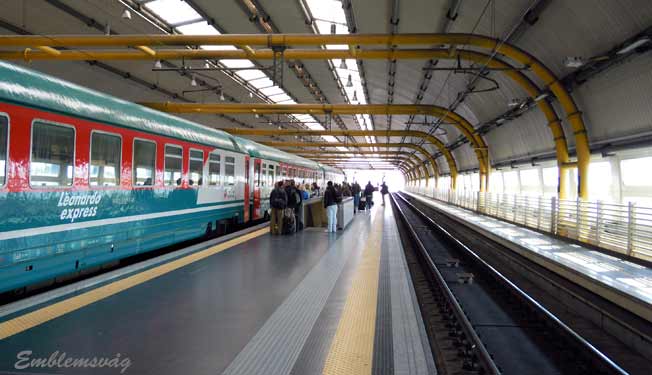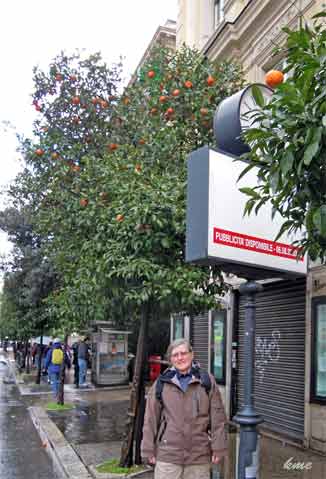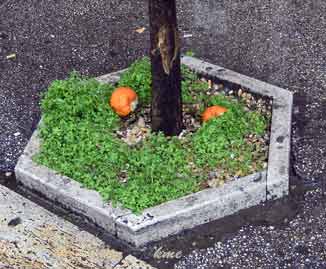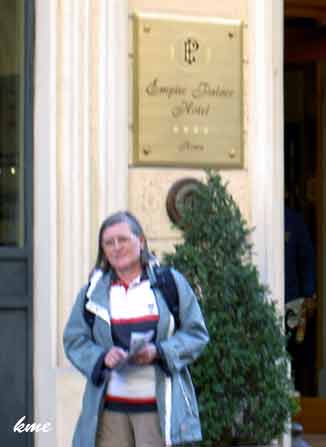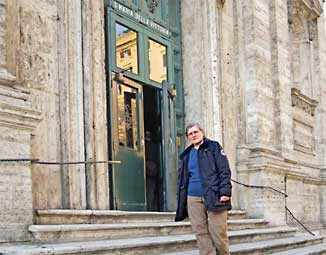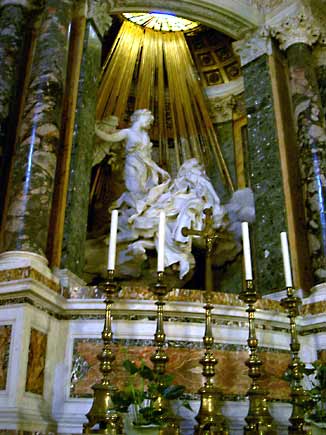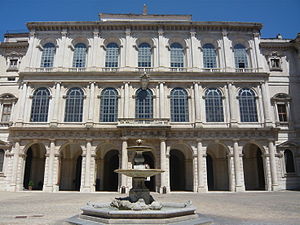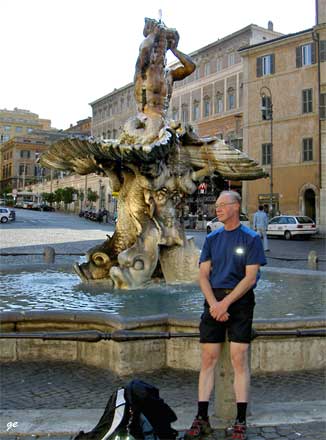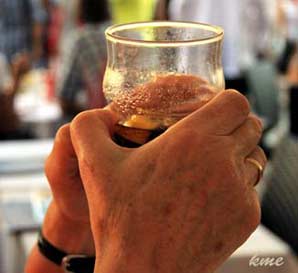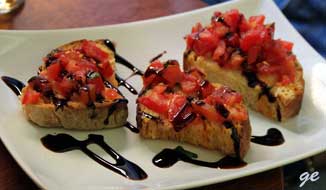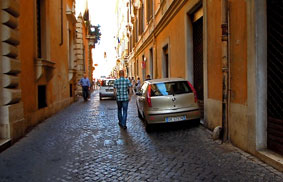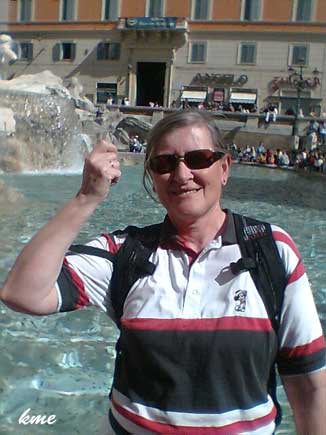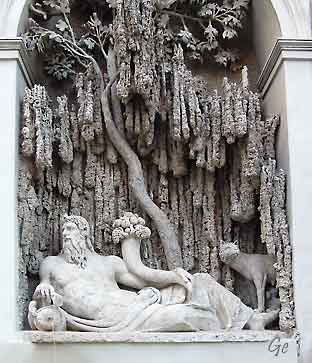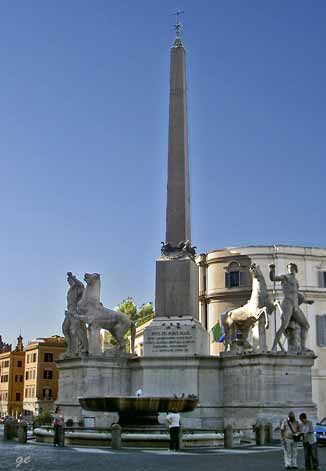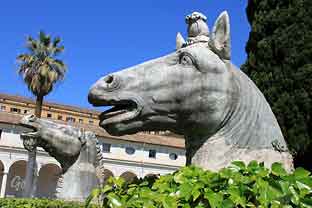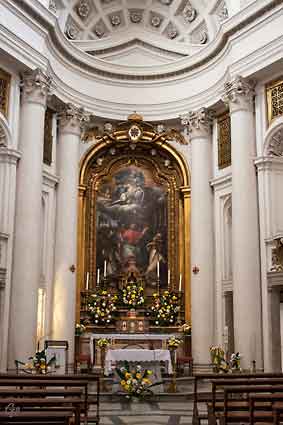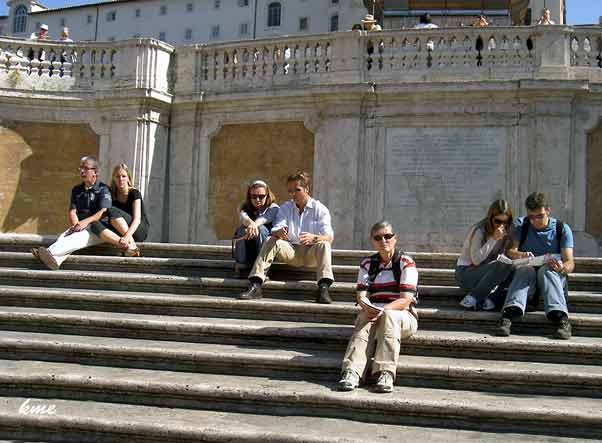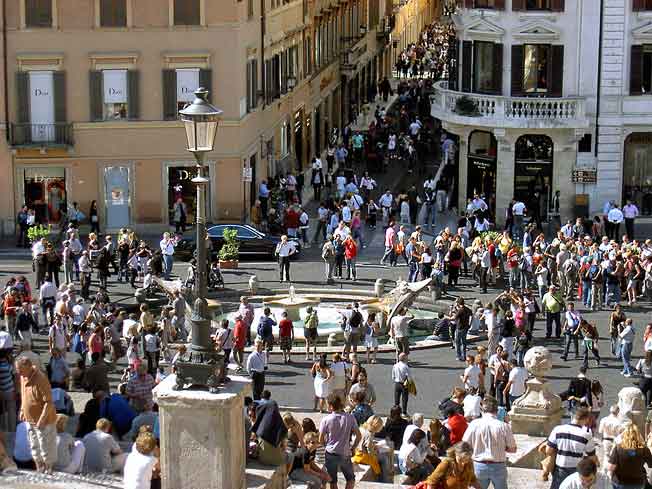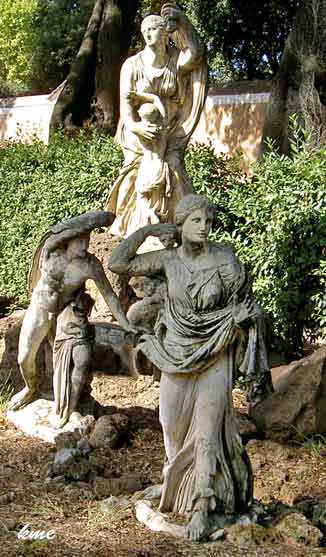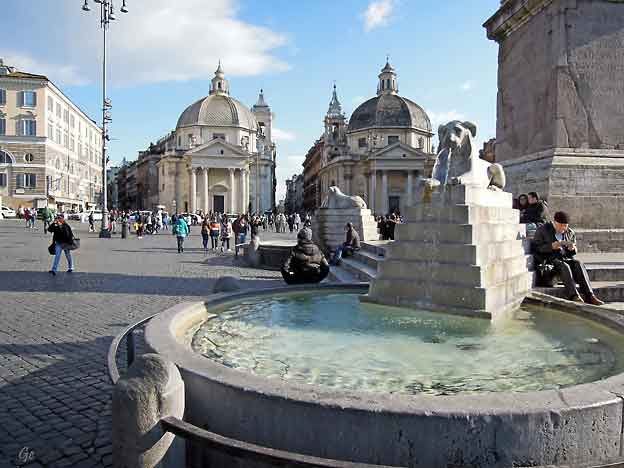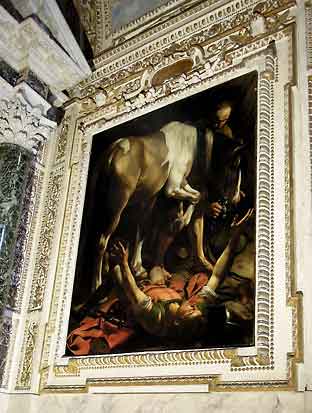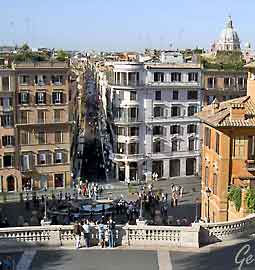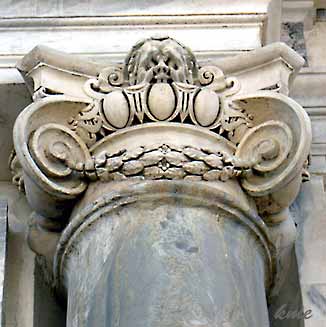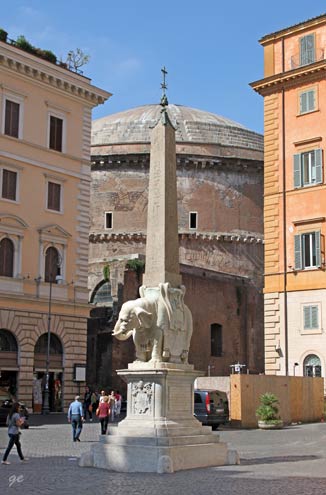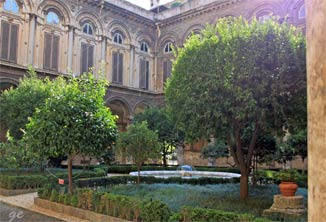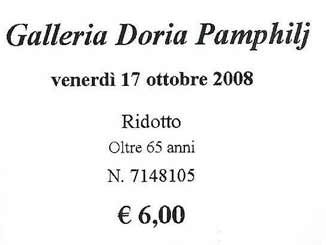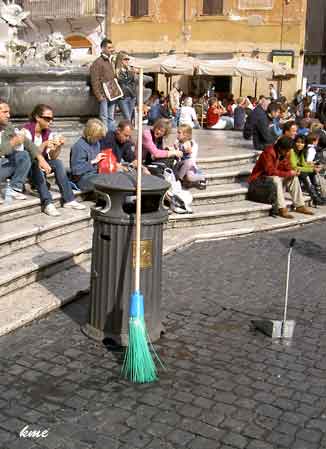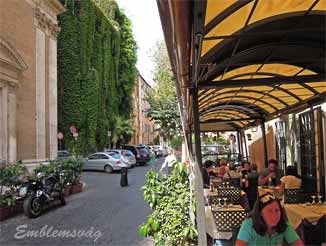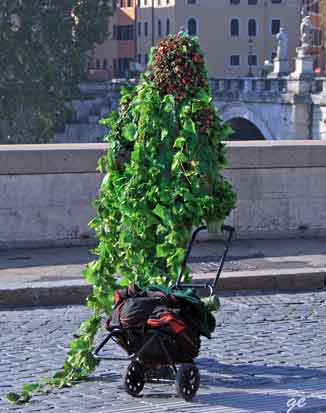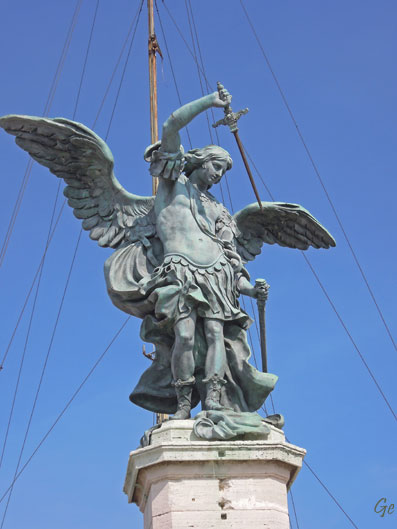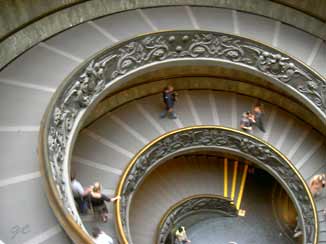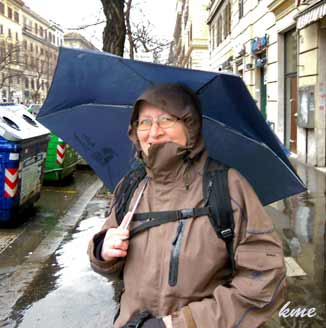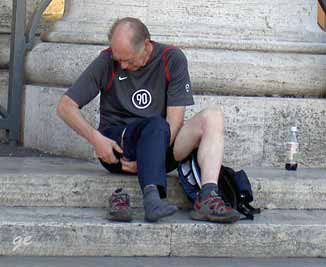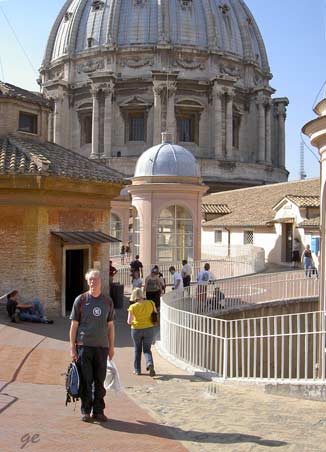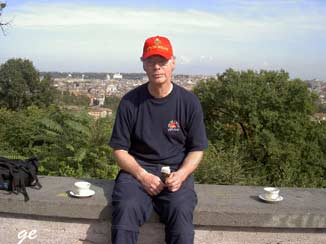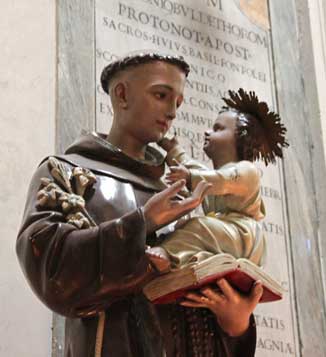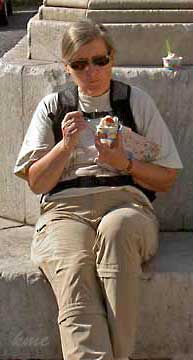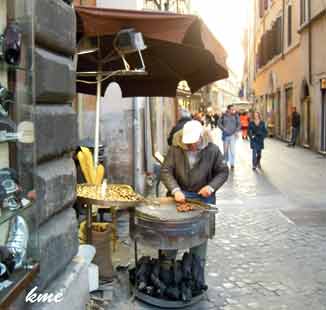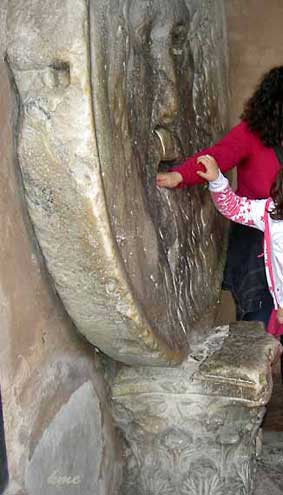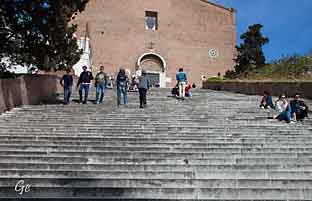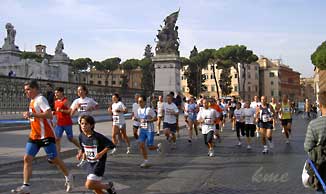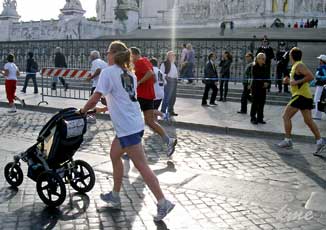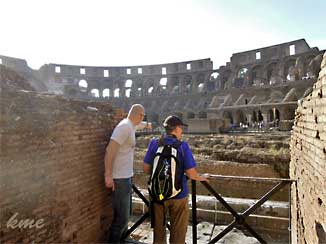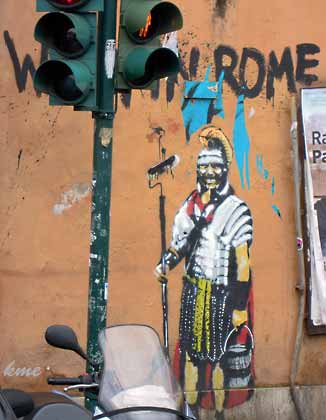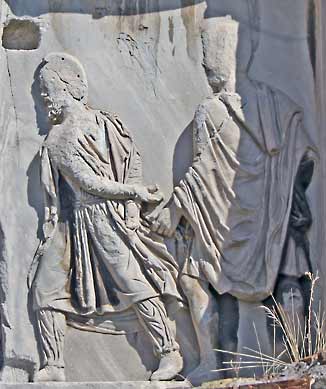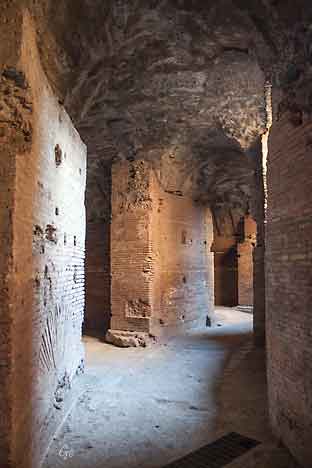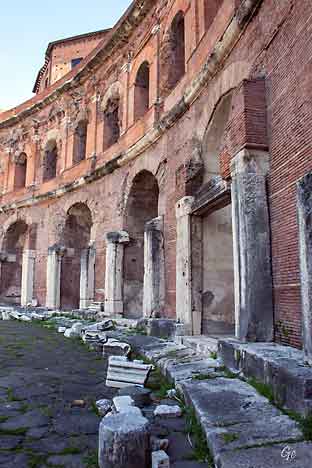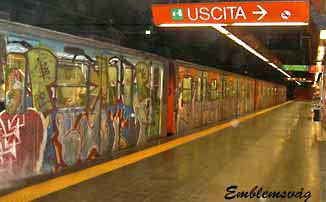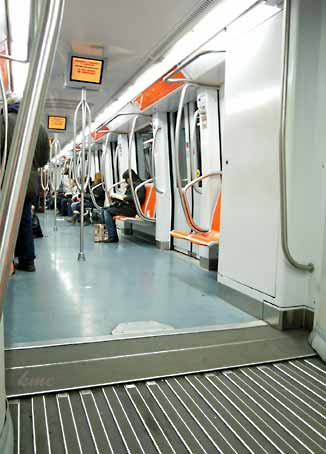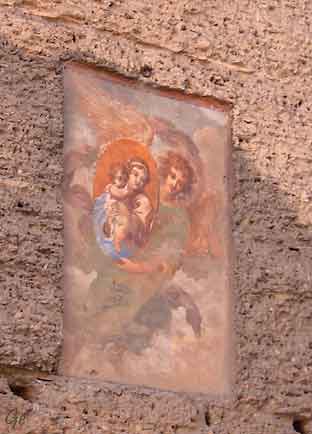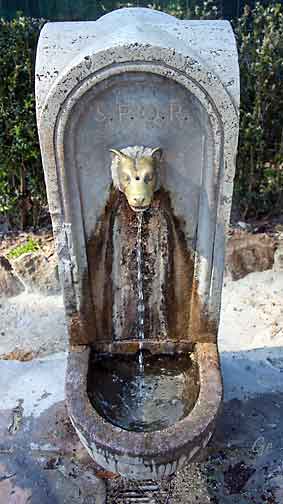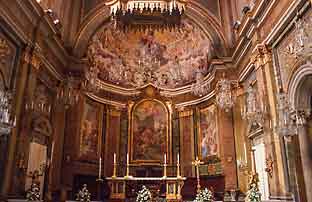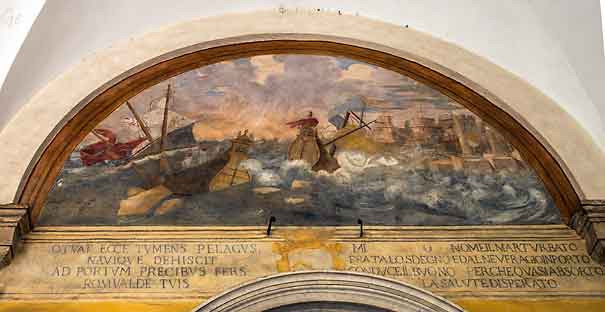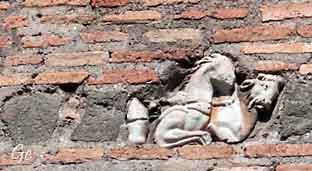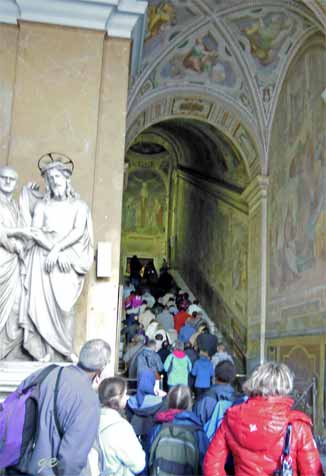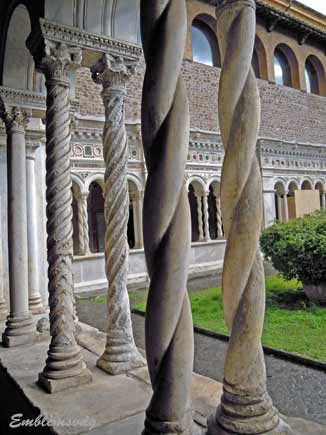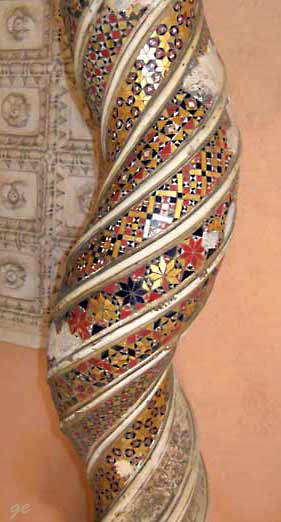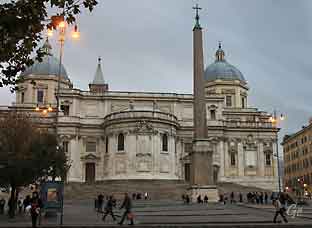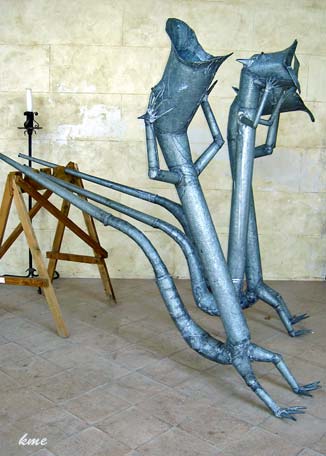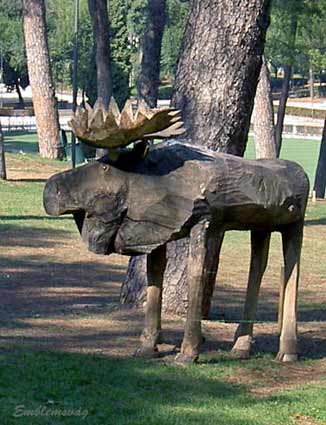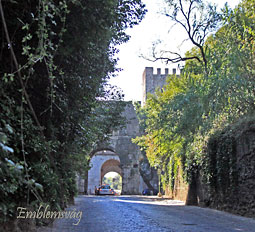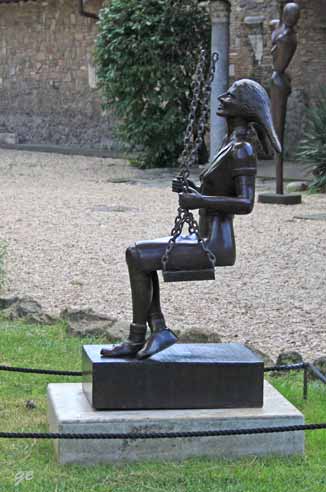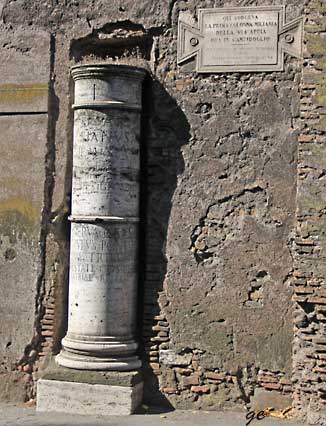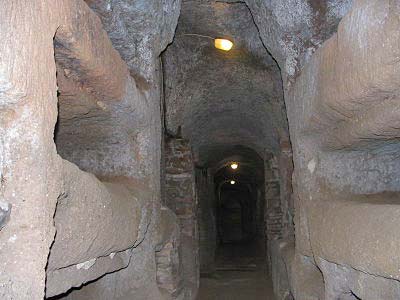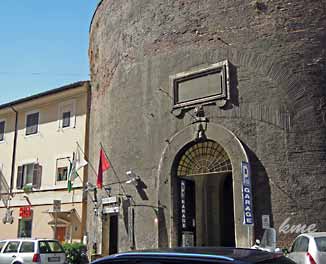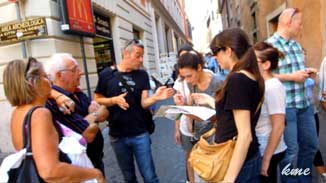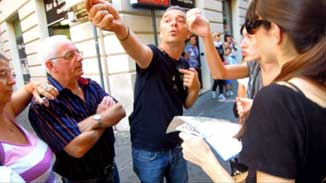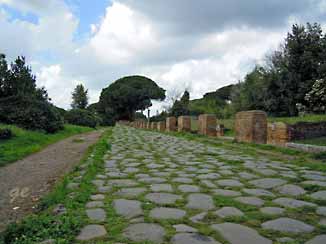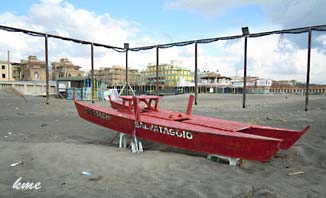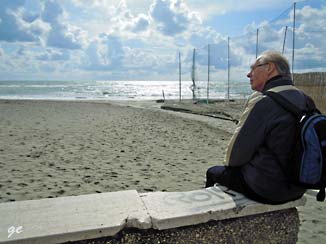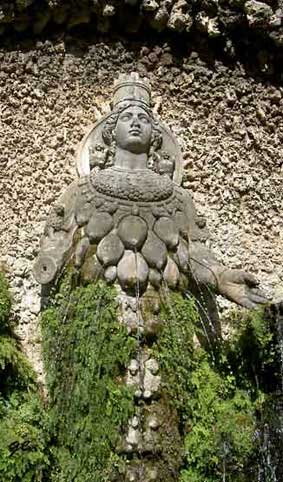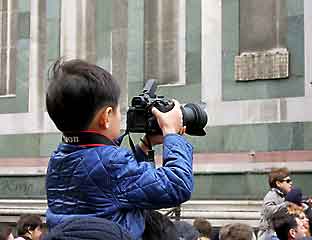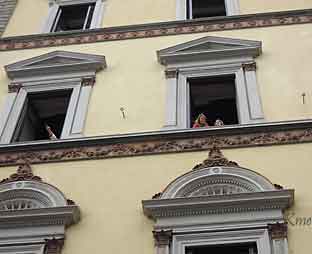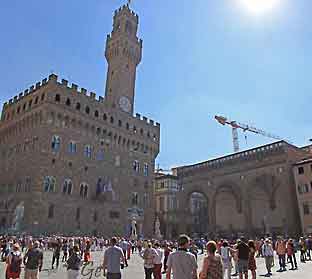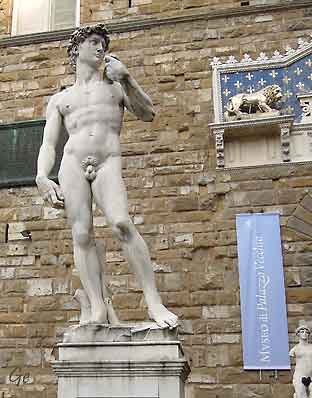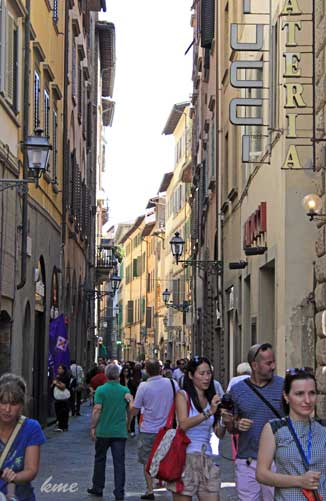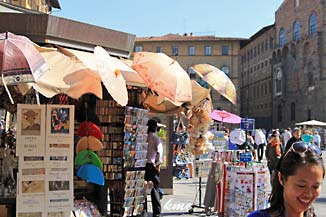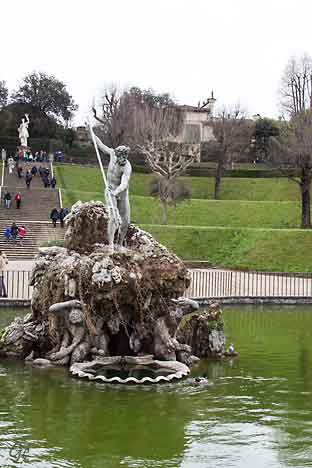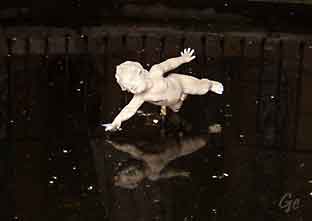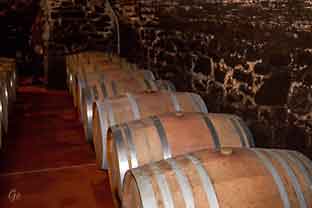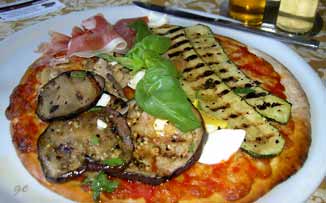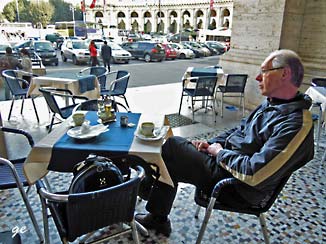Bilder fra Romaturene våre,
og fra FirenzeOktober 2007,
oktober 2008, mars 2010 og september 2013(sammen med Geir)
I oktober 2010 var vi i Roma sammen med Magnus og
Elisabeth. Den turen har fått egen omtale.
endringer 26. mars 2021
endringer 20. januar 2024
| Bydel Via Veneto, Piazza Barberini med Fontana del Tritone, Palazzo Barberini, Kirker i Via Veneto, Santa Maria della Vittoria Bydel Quirinal: Fontana di Trevi Bydel Piazza_di_Spagna: Spansketrappa/Villa Medici/ Pincio/Piazza Popolo, Bydel Piazza della Rotunda Bydel Piazza Navona, Pantheon og Piazza della Minerva, Vatikanet, Castel San Angelo, Bydel Janiculum Bydel Trastevere og Tevere, Bydel Aventin Chianti |
Bydel Campo de Fiori Bydel Capitol Bydel Forum Bydel Palatin: Colosseum Bydel Caracalla Bydel Laterano Bydel Esquilin Ostia Antica/Ostia Lido Villa_Borghese Via Appia Antica. Piazza della Repubblica (to bilder) Det er også bilder fra Romas flyplass Leonardo da Vinci - Fiumicino og Leonardo-ekspressen |
Dessuten fra turene ut av Roma til: Ostia, Tivoli og
Firenze med Chiantidistriktet
tilbake til 1. side
Noen tekster er fra Gyldendals Reiseguider, Roma
|
Den kjører direkte (men ikke spesielt fort) til Roma Termini. (8.3.2010) |
Bydel Via Veneto I keisertidens Roma var dette en forstad der rikfolk hadde villaer og hager. Ruiner fra denne tiden kan sees i utgravningene på Piazza Sallustio, oppkalt etter de mest utstrakte hagene i området, Horti Sallustiane. Etter plyndringene i Roma på 400-tallet ble omådet igjen åpent landskap. Først med byggingen av Palazzo Barberini og den nå forsvunne Villa Ludovisi på 1600-tallet fikk det tilbake den gamle storheten. Da Roma ble hovedstad i Italia i 1870, solgte Ludovisi-familien sin eiendom til byutvikling. De beholdt en tomt for å bygge et nytt hus, men skatten på fortjenesten av salget var så høy at de måtte selge den også. I begynnelsen av 1900-tallet var Via Veneto en gate med smarte, moderne hoteller og kafeer. Gaten spilte en viktig rolle i Fellinis bitende filmsatire: La Dolce Vita fra 1960 om livet til filmstjerner og dovne rikfolk, men siden har gaten mistet sin posisjon som møtested for de berømte. (Fra Gyldendals Reiseguider, Roma) |
||||||
 Ikke noe å si på frokosten på hotellet. (2.10.2007) |
|
||||||
sculptures. ......The prestigious Empire Palace is located in the heart of this part of the city, in the refined rooms of a palece thst was built by Nani Mocenigo the same year Rome became capital. Mocenigo was member of an extremely important Venetian family and he chose the palace as his residence in the eternal city. (Fra skilt på veggen til Imperial Palace hotel) |
|
||||||
Today, Palazzo Barberini houses the Galleria Nazionale d'Arte Antica, one of the most important painting collections in Italy. (Vi var der april 2015) |
(Gjelder flere av hotellene vi har bodd på) Fontenen ble skapt av Bernini for pave Urban VIII Barberini i 1642. (bildet er tatt 30.9.2007) |
||||||
| Bydel Quirinal Som en av Romas opprinnelige syv høyder ble Quirinal i keisertiden hovedsakelig benyttet til boligområde. Øst for høyde lå de kjempestore Diocletians Termer som fremdeles står foran det som nå er hovedjernbanestasjonen. |
Området ble forlatt i middelalderen, men ble populært igjen sent på 1500-tallet. Pavene tok det beste stedet til Palazzo del Quirinale. Betydelige familier som Colonna og Aldobrandini hadde sine palasser lenger nede på høyden. Da pavestyret ble avskaffet i 1870, ble området omkring, og særlig langs Via Nazionale, fornyet da Quirinal ble residens for Italias konger og senere presidenten. (Fra Gyldendals Reiseguider, Roma) |
||||||
|
 Fontenen er utformet av Nicola Salvis og ble ferdig i 1762. På bildet ser vi Triton og en "havhest" Stedet markerte opprinnelig avslutningen av Aqua Virgoakvedukten som ble bygd i 19 f.Kr. (bilde 8.3.2010) |
||||||
Trevi Fountain is the most beautiful fountain in Rome. Measuring some 20 meters in width by 26 meters in height, Trevi Fountain is also the largest fountain in the city. The origins of the fountain go back to the year 19 B.C., in which period the fountain formed the end of the Aqua Virgo aqueduct. The first fountain was built during the Renaissance, under the direction of Pope Nicholas V. The final appearance of the Trevi Fountain dates from 1762, when after many years of works at the hand of Nicola Salvi, it was finalized by Giuseppe Pannini. Interestingly enough, the name of Trevi derives from Tre Vie (three ways), since the fountain was the meeting point of three streets. The myth of the Trevi Fountain Why are there always people in the fountain throwing coins into the water and taking photos of themselves? |
The
myth, originating in 1954 with the movie "Three Coins in the Fountain," goes like this:
right hand over your left shoulder. An interesting statistic is that approximately a million euros worth of coins are taken from the fountain each year. Since 2007 this money has been used to support good causes. https://www.rome.net/trevi-fountain (28.8.2019) |
||||||
|
(bildet er tatt 30.9.2007) |
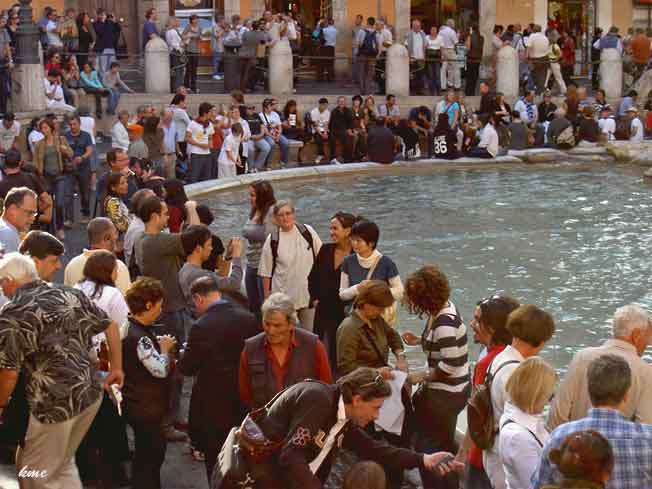 Ved Fontana di Trevi er det alltid mye folk. (bilde 16.10.2008) |
||||||
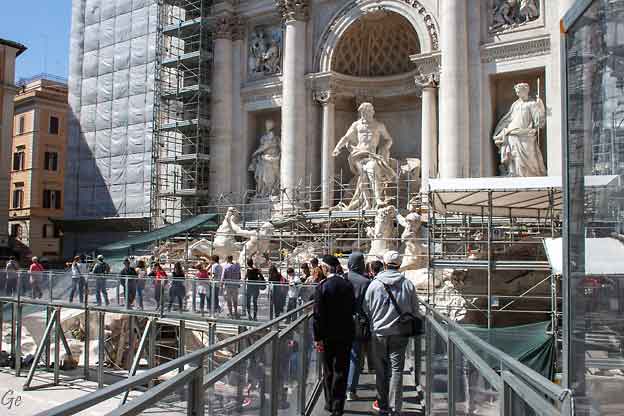 Trevifontena april 2022m |
|
||||||
| The
new fountain that marked the terminus of the
restored aqueduct was the first new monumental wall
fountain in Rome since antiquity. Fontana dell'Acqua Felice - Wikipedia (23. april 2022) |
|||||||
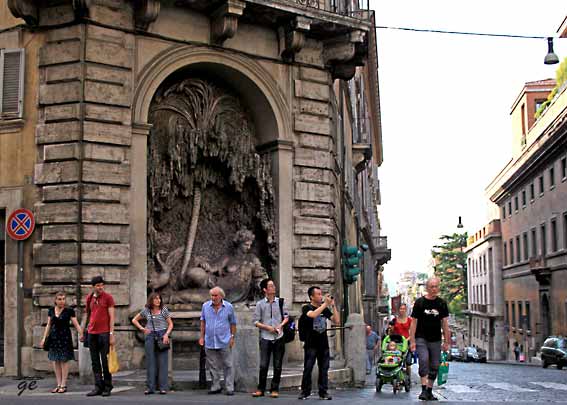 Le Quattro Fontane, Styrkens (eller Junos) fontene. (28.9.2013) Det er fire fontener festet til bygningene i krysset mellom to travle gater. De stammer fra den store byfornyelsen av Roma under Sixtus V (1585-1590) En fontene representerer elveguden som er fulgt av ulvinnen, tydelig Tevere. Den andre mannlige skikkelsen kan være Arno. De kvinnelige skikkelsene representerer styrke og trofasthet eller gudinnene Juno og Diana. (Over er Diana)(fra Gyldendals reiseguider) |
|
||||||
 Fontenen på Piazza Quirinale (23.9.2013) |
Piazza del Quirinale & Palazzo del Quirinale - Rome (23. april 2022) |
||||||
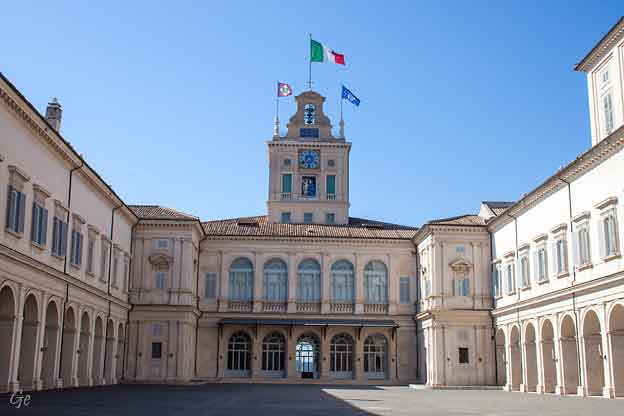 Presidentpalasset, eller Palazzo del Quirinale april 2015 |
The
palace, located on the Via del Quirinale and
facing onto the Piazza del Quirinale, was built in 1583 by Pope Gregory XIII as a papal summer residence. The pope wanted to find a location which would have been far away from the humidity and stench coming from the river Tiber and the unhealthy conditions of the Lateran Palace, therefore the Quirinal hill was one of the most suitable places in Rome. On the site, there was already a small villa owned by the Carafa family and rented to Luigi d'Este.The pope commissioned the architect Ottaviano Masherino to build a palace with porticoed parallel wings and an internal court. The project was not fully completed due to the death of the pope in 1585 but it is still recognisable in the north part of the court, especially in the double loggia facade, topped by the panoramic Torre dei venti (tower of the winds) or Torrino. To the latter, a bell tower was added according to a project by Carlo Maderno and Francesco Borromini. The Quirinal Palace (known in Italian as the Palazzo del Quirinale or simply Quirinale) is a historic building in Rome, the current official residence of the president of the Italian Republic. http://en.wikipedia.org/wiki/Quirinal_Palace |
||||||
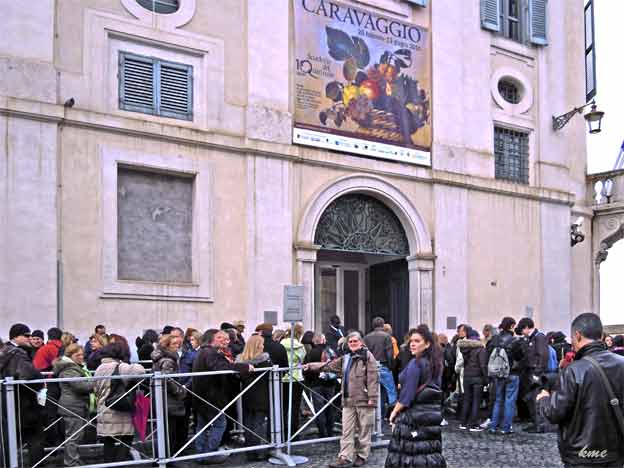 Caravaggioutstilling i Scuderie del Quirinale (10.3.2010) Scuderie del Quirinale ligger på Piazza del Quirinale |
|
||||||
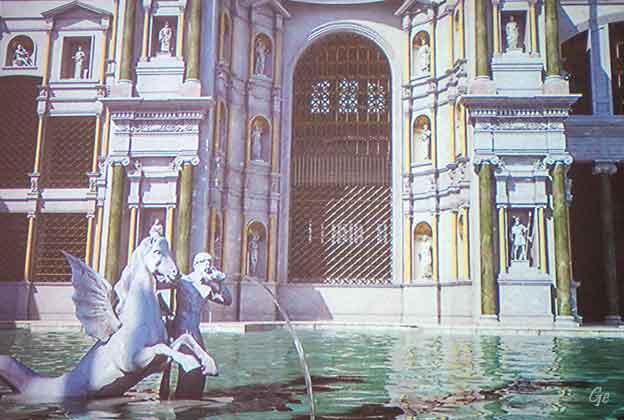 Diocletians termer april 2015 The Baths of Diocletian (Latin: Thermae Diocletiani, Italian: Terme di Diocleziano) were public baths in ancient Rome. Named after emperor Diocletian and built from 298 AD to 306 AD, they were the largest of the imperial baths. The project was originally commissioned by Maximian upon his return to Rome in the autumn of 298 and was continued after his and Diocletian's abdication under Constantius, father of Constantine.The baths were open until c. 537, when the Ostrogoths cut off aqueducts from the city of Rome. |
The site houses the Basilica of Santa Maria degli Angeli e dei Martiri, built within the ruins in the 16th century, as well as the Church of San Bernardo alle Terme and part of the National Roman Museum. The baths occupy the high-ground on the northeast summit of the Viminal, the smallest of the Seven hills of Rome, just inside the Agger of the Servian Wall (near what are today the Piazza della Repubblica and Termini rail station). They served as a bath for the people residing in the Viminal, Quirinal, and Esquiline quarters of the city. The Quadrigae Pisonis, a 2nd-century monument with various reliefs, some private homes, and a relief representing the temple of Quirinus once stood at the site but were demolished to build the baths. The water supply was provided by the Aqua Marcia, an aqueduct that had long served the city of Rome since the early 2nd century. To properly supply the baths, the supply of water to the city was increased under the order of Diocletian. The baths may have also been supplied by the Aqua Antoniniana, which was originally positioned to supply Caracalla's baths in the early 3rd century The baths were commissioned by Maximian in honor of co-emperor Diocletian in 298 AD, the same year he returned from Africa. Evidence of this can be found in bricks from the main area of the baths, which distinctly show stamps of the Diocletianic period. These, according to the ancient guidebook Mirabilia Urbis Romae, were known as "Palatium Diocletiani". This evidence shows the effect of the massive project on the brick industry in that all work by them was redirected and under control of the emperor. Building took place between the year it was first commissioned and was finished sometime between the abdication of Diocletian in 305 and the death of Constantius in July 306. Baths of Diocletian - Wikipedia (23. april 2021) |
||||||
 Midt på plassen står Fontana delle Naiadi. Fontenen er laget av Mario Rutelli. De fire nakne bronsenymfene førte til litt av en skandale da de ble avduket i 1901. (1.10.2007) __________________________________________________________________________________ Vi har også vært i kirke Santi Vinconzi e Ananstasio Santi Vincenzo e Anastasio a Trevi ("Saints Vincent and Anastasius at Trevi") is a Baroque church in Rome, the capital of Italy. Built from 1646 to 1650 to the design of architect Martino Longhi the Younger and located in close proximity to the Trevi Fountain and the Quirinal Palace, for which it served as parish church, it is notable as the place where the precordia and embalmed hearts of 25 popes from Sixtus V to Leo XIII are preserved.Santi Vincenzo e Anastasio a Trevi lies on the location of a medieval church, mentioned in 962 in a bull by Pope John XII as a b ranch of the San Silvestro in Capite basilica as well as in 15th century records. Known as Santi Vincenzo e Anastasio since the 16th century, it was rebuilt in the Baroque style and completed in 1650. http://en.wikipedia.org/wiki/Santi_Vincenzo_e_Anastasio_a_Trevi |
Kirker i bydelen Quirinal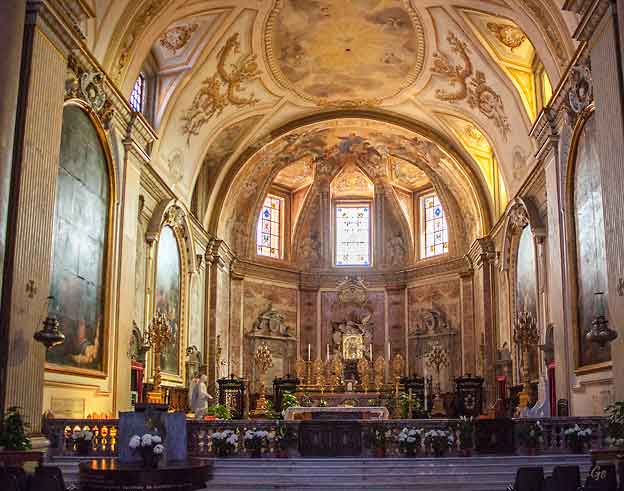 (april 2015) The Basilica of St. Mary of the Angels and of the Martyrs is a basilica and titular church in Rome, Italy, built inside the ruined frigidarium of the Roman Baths of Diocletian in the Piazza della Repubblica. It was constructed in the 16th century following an original design by Michelangelo Buonarroti. Other architects and artists added to the church over the following centuries. During the Kingdom of Italy, the church was used for religious state functions. The basilica is dedicated to the Christian martyrs, known and unknown. By a brief dated 27 July 1561, Pius IV ordered the church "built", to be dedicated to the Beatissimae Virgini et omnium Angelorum et Martyrum ("the Most Blessed Virgin of all the Angels and Martyrs"). Impetus for this dedication had been generated by the account of a vision of the Archangel Uriel experienced in the ruins of the Baths in 1541 by a Sicilian monk, Antonio del Duca, who had been lobbying for decades for papal authorization of a more formal veneration of the Angelic Princes. A story that these Martyrs were Christian slave labourers who had been set to constructing the Baths is modern. It was also a personal monument of Pope Pius IV, whose tomb is in the apsidal tribune. Santa Maria degli Angeli e dei Martiri - Wikipedia (23. april 2022) |
||||||
|
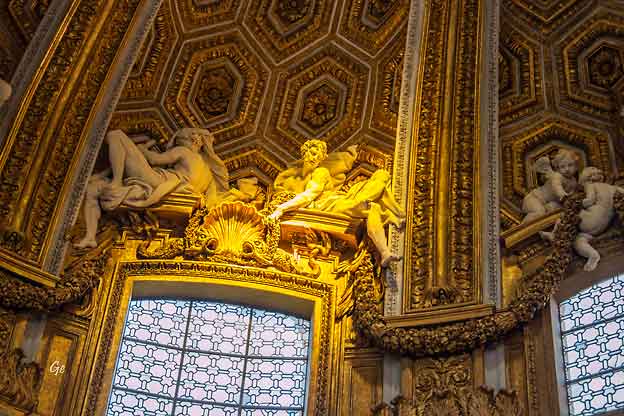 Sant'Andrea al Quirinale (april 2015) The Church of Saint Andrew on the Quirinal is a Roman Catholic titular church in Rome, Italy, built for the Jesuit seminary on the Quirinal Hill. The church of Sant'Andrea, an important example of Roman Baroque architecture, was designed by Gian Lorenzo Bernini with Giovanni de'Rossi. Bernini received the commission in 1658 and the church was constructed by 1661, although the interior decoration was not finished until 1670. The site previously accommodated a 16th-century church, Sant'Andrea a Montecavallo.Commissioned by former Cardinal Camillo Francesco Maria Pamphili, with the approval of Pope Alexander VII, Sant'Andrea was the third Jesuit church constructed in Rome, after the Church of the Gesù and Sant'Ignazio. It was to serve the Jesuit novitiate, which was founded in 1566. Bernini considered the church one of his most perfect works; his son, Domenico, recalled that in his later years, Bernini spent hours sitting inside it, appreciating what he had achieved. The French dramatist Victorien Sardou set the first act of his play La Tosca in the church. Sant'Andrea al Quirinale - Wikipedia (23. april 2022) |
||||||
|
a façade inspired by his prior work of the Church of the Gesu. It has two rows of Corinthian pilasters that are connected with volutes. (The façade was renovated in 1991–92) Above the door is a dedicatory inscription and votive niches. The work was continued by Carlo Lombardi and Flaminio Ponzio. Original to this phase are the statues by Giovanni Anguilla of the four major prophets of the Old Testament in the niches of the dome (1599). http://en.wikipedia.org/wiki/Santa_Maria_ai_Monti |
||||||
| Bydel Piazza di Spagna På 1500-tallet førte økningen i antall pilegrimer og geistlige som strømmet til Roma, til at livet i Romas allerede overbefolkede middelaldersentrum ble uutholdelig. Det ble bygd en ny trekant med veier som fremdeles eksisterer, for å sluse pilegrimene raskest mulig fra byens nordlige port, Porta del Popolo, til Vatikanet. |
På
1700-tallet var det hoteller over hele distriktet. I
dag har området mye mer å tilby; de ypperlige eksemplene på renessanse- og barokkunst i Santa Maria del Popolo og Sant Andrea delle Fratte, de praktfulle relieffene på det restaurerte Ara Pacis, kunstutstillingenen i Villa Medici, den fine utsikten over byen fra den spanske trappen og fra Pinchio-hagegene, og Romas mest berømte handlegater rundt Via Condotti med spennende butikker. (Fra Gyldendals Reiseguider, Roma) |
||||||
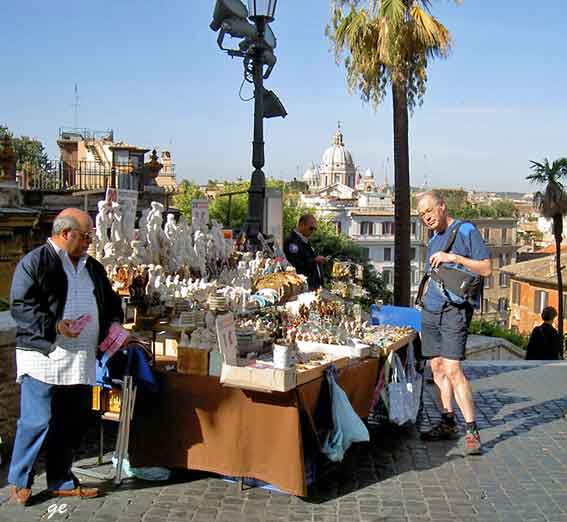 Øverst i den Spanske Trappa er det mange souvenirselgere. (30.7.2007) |
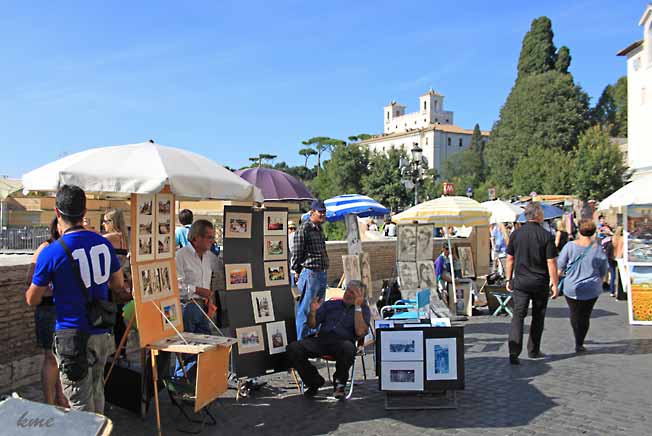 Øverst i den Spanske Trappa (23.9.2013) |
||||||
|
Grete tar en hvil i den Spanske Trappa. På 1600-tallet bestemte de franske eierne av kirken Trinita dei Monti seg for å forbinde kirken med Piazza di Spagna ved hjelp av en flott trapp. Trappen ble ikke bygd før 1726. (bilde 30.9.2007) |
av Gian Lorenzo Bernini eller av hans far Pietro. (Barcaccia betyr ubrukelig, gammel båt.) På
plassen ligger tesalongen
Babingtons som ble åpnet i 1896 av to engelske
På 1600-tallet hadde Spanias ambassadør til pavestolen sitt hovedkvarter på piazzaen, og området rundt ble ansett som spansk territorium. Utlendinger som uforvarende kom inn på området, risikerte å bli tvunget inn i den spanske hæren. (bilde 30.9.2007) |
||||||
|
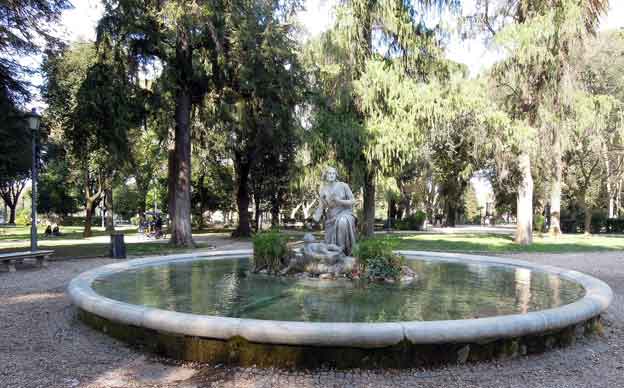 Pinciohagene (23.9.2013) Fontana del Mose Salvator, Mosesfontena The Pincian Hill, one of the most romantic and picturesque places in the Capital, is a Roman hill (although not one of the Seven Hills) offering a breathtaking view of the Piazza del Popolo and the city. It is part of the Villa Borghese and is within the Aurelian Walls. The balcony overlooks the Piazza del Popolo and the Villa Medici. Pincian Hill (Il Pincio), Rome - Italy - ItalyGuides.it (23. april 2022) |
||||||
|
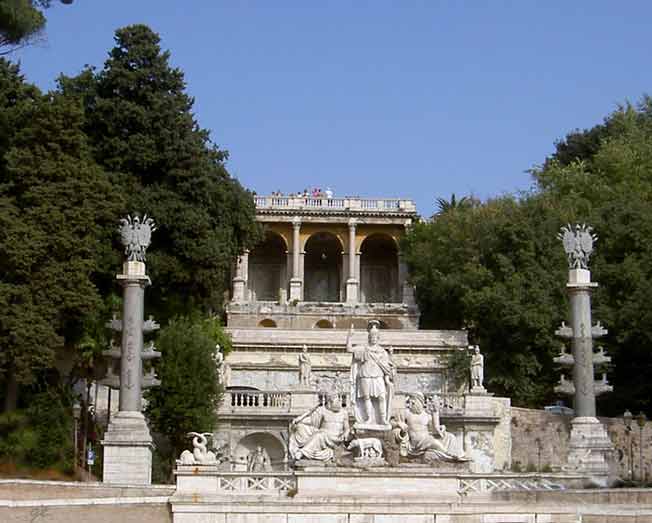 Det er heller ikke langt til Piazza Poppolo Fra terrassen er det fin utsikt over Roma. Rett bak terrassen ligger Pincio-hagene. (Fontenen er Neptunfontenen, Fontana del Nettuno. Bilde 3.10.2007) |
||||||
|
Between the elegant Pincio, and the banks of the Tevere, Piazza del Popoloyawns into an enormous ellipse. Churches, fountains, monuments, and marble memoirs of historic events in Rome both ancient and modern tastefully embellish the square. Since antiquity, the city's Northern entrance formed a vestibule into the city through the gate in the Aurelian Walls. Though now known as Porta del Popolo, it has had various names over the centuries. Originally called Porta Flaminia by the Emperor Aurelianus who commissioned its construction, during the Early Medieval period, it was called Porta San Valentino, after the nearest Catacomb. Finally the name Porta del Popolo was agreed on, as the church adjoining the gate is Santa Maria del Popolo. http://www.italyguides.it/en/lazio/rome/squares-and-fountains/piazza-del-popolo
|
Piazza del Popolo itself was known as Piazza del Trullo in the Middle Ages, after the conical fountain which once stood in the centre of the square, reminiscent of a characteristic South-Italian dwelling. Its present name may be due to the poplar tree, known in Latin as "populus" which also meant people, an apt association, as various public events such as fairs, games and dramatic executions were held there. http://www.italyguides.it/en/lazio/rome/squares-and-fountains/piazza-del-popolo |
||||||
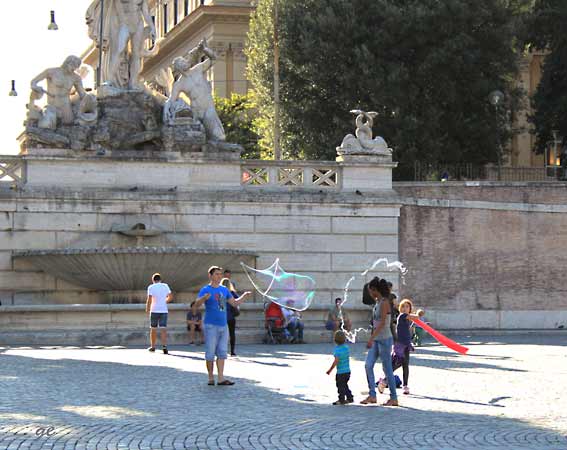 Såpebobler på Piazza del Popolo Fontena er Neptunfontena, Fontana del Nettuno |
 Fredsalteret Ara Pacis Alteret hyller freden leiser Augustus skaffet over hele middelhavsomrpdet etter seierrike felttog i Gallia og Spania. monumentet ble bestilt av senatet i 13 f. Kr og fullført 4 år senere. Det ble plassert slik at skyggen fra det store soluret på Campus Martius ville falle på det på Ausgustus fødselsdag. (Gyldendals reiseguider) |
||||||
|
Kirker i Spagna
|
||||||
| Bydel Piazza della Rotunda Pantheon er en av de store bygningene i europeisk arkitekturhistorie, og har stått i sentrum av Roma i nesten 2000 år. Dette historiske området har opplevd uavbrutt økonomisk og politisk aktivitet i hele denne tiden. Palazzo di Montecitorio, bygd for pave Innocens XII som pavetribunal i 1694, er nå det italienske parlamentet, og mange av bygningene er regjeringskontore |
Det er også Romas viktigste finansdistrikt med bankhovedkvarterer og aksjebørsen. Det bor ikke mange mennesker her, men om kvelden slentrer romerne rundt i de smale gatene og fyller de livlige restaurantene og kafeene som gjør dette området til et senter for byens sosiale liv. (Fra Gyldendals Reiseguider, Roma) |
||||||
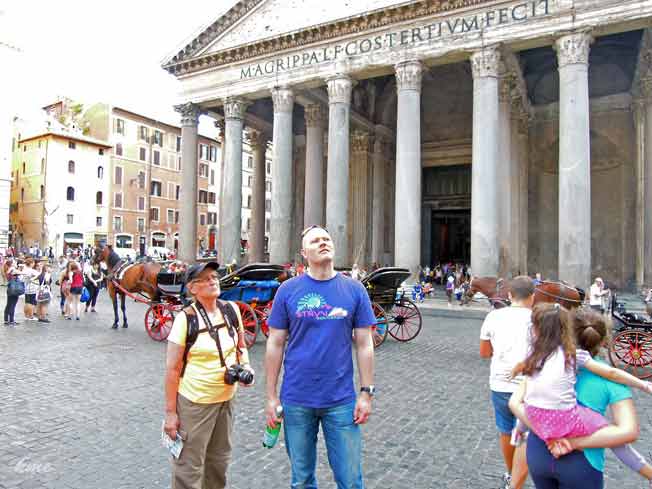 Pantheon "templet for alle guder", senere kirke. Pantheon ble bygget av keiser Hadrian (118-125 e. kr.) (28.9.2013) |
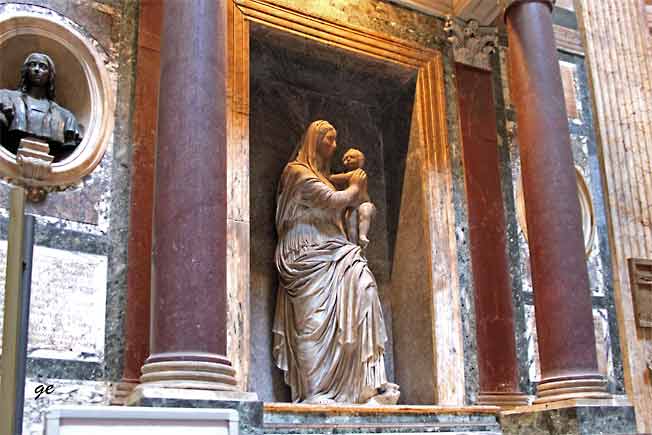 Raffeals grav i Pantheon Over grava står en Madonna av Lorenzetto (1520) (bildet fra 26.9.2013) Raffaello Santi, bedre kjent som Rafael (født 6. april 1483, død 6.april 1520), var en maler og arkitekt under den italienske renessansen. Han ble også kalt Raffaello Sanzio, Raffaello de Urbino og Rafael Sanzio de Urbino. http://no.wikipedia.org/wiki/Rafael |
||||||
På Piazza della Minerva ligger også kirken Santa Maria Sopre Minerva. Vi var inne i den i 2013. Santa
Maria sopra Minerva is one of the
major churches of the Roman
Catholic Order The church
is located in Piazza della Minerva one
block behind the Pantheon in
the Pigna While many
other medieval churches in Rome have been
given Baroque makeovers that |
Sant'Ignazio di Loyola in CampoMarzio, Latin: Ecclesia Santi Ignatii a Loyola in Campo Martio) is a Roman Catholic titular church, of deaconry rank, dedicated to Ignatius of Loyola, the founder of the Society of Jesus, located in Rome, Italy. Built in Baroque style between 1626 and 1650, the church functioned originally as the chapel of the adjacent Roman College, that moved in 1584 to a new larger building and was renamed the Pontifical Gregorian University. https://en.wikipedia.org/wiki/Sant%27Ignazio,_Rome (29.8.2019) |
||||||
| Bydel Piazza Navona Fundamentene til bygningene som omgir Piazza Navonas lange oval, er ruinene av tribunene til Diocletians kolossale stadion. Piazzaen er fremdeles et dramatisk skue med obelisken ved Fontana dei Quattro Fiumi som blikkfang foran kirken Sant Agnese in Agone. Barokken er den dominerende stilen i området, og mange av de fineste bygnigene stammer fra Innocens X Pamphilj (pave 1644-1655), Berninis og Borrominis beskytter. |
Komplekset Chiesa Nuova er av spesiell interesse. Det var hovedkvarteret til Den hellige treenighets brorskap, ordenen som ble grunnlagt av San Filippo Neri, "Romas apostel" på 1500-tallet. (Fra Gyldendals Reiseguider, Roma) |
||||||
|
Sant'Andrea della Valle is a minor basilica in the rione of Sant'Eustachio of the city of Rome, Italy. The basilica is the general seat for the religious order of the Theatines. It is located at Piazza Vidoni, 6 at the intersection of Corso Vittorio Emanuele (facing facade) and Corso Rinascimento. A church was initially planned when, in 1582, Donna Costanza Piccolomini d'Aragona, duchess of Amalfi and descendant of the family of Pope Pius II, bequeathed her palace and the adjacent church of San Sebastiano in central Rome to the Theatine order for construction of a new church. Since Amalfi's patron was Saint Andrew, the church was planned in his honor. Work initially started around 1590 under the designs of Giacomo della Porta and Pier Paolo Olivieri, and under the patronage of Cardinal Gesualdo. With the previous patron's death, direction of the church passed to Cardinal Alessandro Peretti di Montalto, nephew of Pope Sixtus V. Work restarted by 1608, financed by what was then an enormous endowment of over 150,000 gold scudi, and with a more grandiose plan designed mainly by Carlo Maderno. The interior of the church was completed by 1650, with some changes added by Francesco Grimaldi. Sant'Andrea della Valle - Wikipedia (24. april 2022) |
||||||
 Fontana dei Quattro Fiumi (26.9.2013) Bildet over: Det blir hevdet at Rio de la Platas atletiske skikkelse som kryper sammen med armen i været uttrykker Berninis frykt for at den nærliggende kirken Sant Agnese in Agone skal falle sammen. Kirken er utformet av hans rival Borromini. Dette kan ikke være riktig. Bernini var ferdig med fontenen før Borromini startet arbeidet med kirken. |
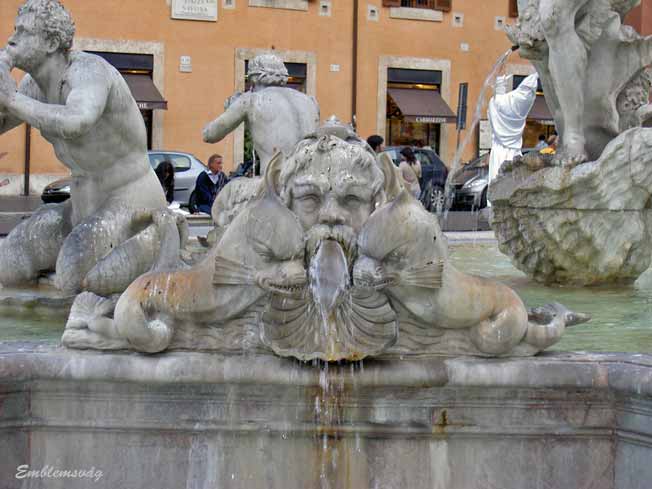 Piazza Navona er en populær møteplass. Det er tre fontener på plassen, bassenget på Fontana di Nettuno i nordenden av plassen er bygd av Giacomo della Porta i 1576, mens statuene av Neptun og nereidene er fra 1800-tallet. Midt på pladfssen står Fontana dei Quattro Fiumi, bygd for pave Innocens X Pamphilj og avduket i 1651. Bernini utformet fontenen og den ble betalt med svært upopulære skatter på brød og andre viktige varer. (4.10.2007) |
||||||
Vatikanet
|
Castel San Angelo 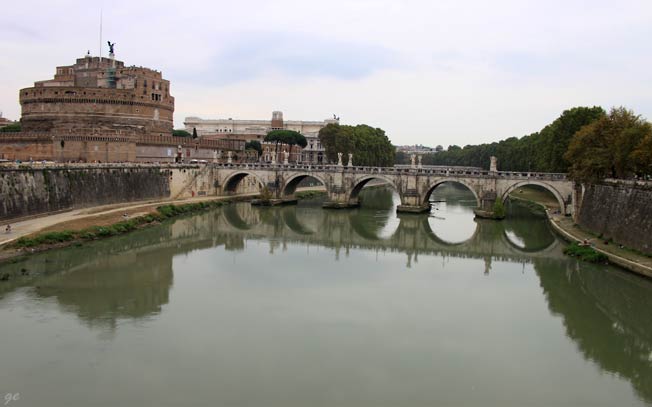 Borgen Sant Angelo Borgen har navn etter den visjonen pave Gregor den store hadde av erkeengelen Mikael på dette stedet. Den ble bygd i 139 e.Kr. som keiser Hadrians mausoleum. Siden har den hatt mange roller: del av keiser Aurelians bymus, festning og fengsel i middelalderen og residens for pavene i tider med politisk uro. (2.10.2007) |
||||||
|
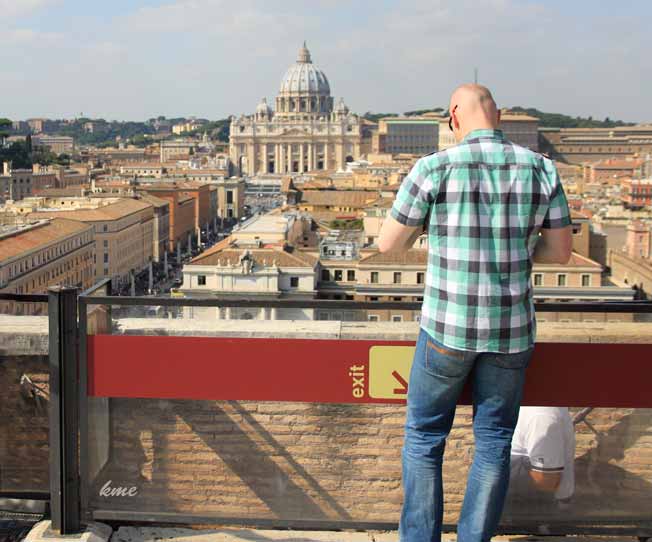 Geir på den øverste terrassen på Castel Sant Angelo. Utsikt mot Peterskirken. (28.9.2013) |
||||||
 Kaffe og øl på kafeen på Castel Sant Angelo. (28.9.2013) |
 Det er lang kø til Vatikanmuseet. (Men det går utrolig raskt framover i køen.) Bygningen var opprinnelig pavepalasser. (3.10.2007) |
||||||
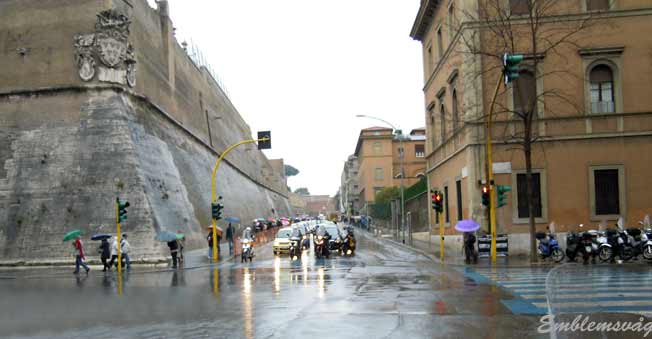 Køen var ikke fullt så lang en regnværsdag i mars. (9.3.2010) |
|
||||||
|
Den første
Peterskirken ble bestilt av keiser Konstantin og sto
ferdig i 349 e.Kr. På 1400-tallet begynte den å rase sammen, så i 1506 la pave Julius II grunnsteinen til en ny kirke. Det tok over hundre år å bygge kirken. Bilde: Messe på Petersplassen søndag 29. september 2013) 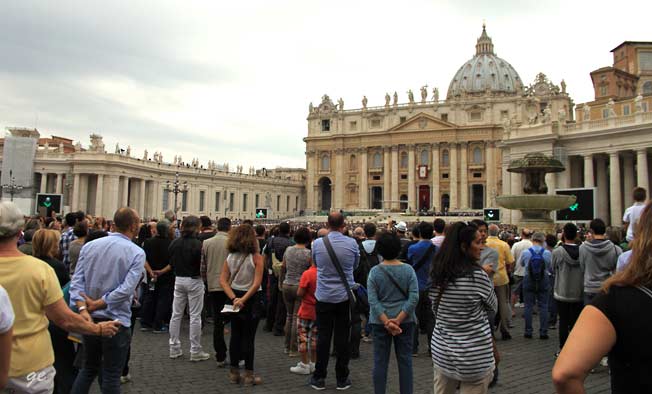 |
||||||
 Gregorio XIII in Basilica di San Pietro. Fra Peterskirken (29.9.2013) |
born Alberto di Morra, reigned from 25 October to his death in 1187. http://en.wikipedia.org/wiki/Pope_Gregory_VIII |
||||||
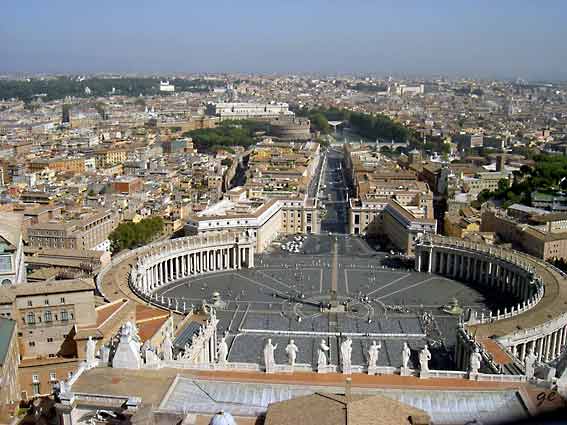 Utsikten fra kuppelen på Peterskirken |
|
||||||
Bydel Janiculum Med sin utsikt over Tevere fra Trasteveresiden av elven har Janiculum ofte spilt en rolle i forsvaret av byen. Siste gang var i 1849 da Garibaldi holdt tilbake de angripende franske styrkene. Parken som ligger på toppen av høyden, er fylt med monumenter over Garibaldi og hans menn. Parken er et svært populært sted for spaserturer, og den tilbyr et kjærkomment pustehull fra de tettpakkede gatene i Trastevere. |
Du finner ofte dukketeatere og annen underholdning for barn der. I middelalderen var det meste av høyden opptatt av nonne- og munkeklostere. I klosteret San Pietro in Montorio bygde Bramante sitt miniatyrmesterverk Tempietto. I renessansen ble også områdenen mot elvebredden bygd ut langs Via della Lungara, og der bygde de rike og mektige slike store og vakre hus som Villa Farnesina. (Fra Gyldendals Reiseguider, Roma) |
||||||
The Janiculum, occasionally the Janiculan Hill, is a hill in western Rome, Italy. Although it is the second-tallest hill (the tallest being Monte Mario) in the contemporary city of Rome, the Janiculum does not figure among the proverbial Seven Hills of Rome, being west of the Tiber and outside the boundaries of the ancient city. Ancient history and mythology The Janiculum was a center for the cult of the god Janus: its position overlooking the city made it a good place for augurs to observe the auspices. In Roman mythology, Janiculum is the name of an ancient town founded by the god Janus (the two-faced god of beginnings). In Book VIII of the Aeneid by Virgil (Publius Vergilius Maro), King Evander shows Aeneas (the Trojan hero of this epic poem) the ruins of Saturnia and Janiculum on the Capitoline Hill near the Arcadian city of Pallanteum (the future site of Rome) . Virgil uses these ruins to stress the significance of the Capitoline Hill as the religious center of Rome. According to Livy, the Janiculum was incorporated into ancient Rome during the time of king Ancus Marcius to prevent an enemy from occupying it. It was fortified by a wall, and a bridge was built across the Tiber to join it to the rest of the city. During the war between Rome and Clusium in 508 BC, it is said that the forces of Lars Porsena occupied the Janiculum and laid siege to Rome. The water mills The Aurelian Walls were continued up the hill by the emperor Aurelian (reigned AD 270–275) to include the water mills used to grind grain to provide bread flour for the city. The mills were supplied from an aqueduct, where it plunged down a steep hill. Thus the site resembles Barbegal, although excavations in the late 1990s suggest that they may have been undershot rather than overshot in design (i. e. with the stream entering at the bottom of the wheel, not the top). The mills were in use in AD 537, when the Goths besieging the city cut off their water supply. But they were later restored and may have remained in operation until at least the time of Pope Gregory IV (827–844). Janiculum - Wikipedia (25. april 2022) |
 Utsikt fra Piazzale Giuseppe Garibaldi i Janiculum. Vi gikk hit opp fra Vatikanet. På plassen kjøpte vi kaffe og is, før vi gikk ned til Trastevere. (19.10.2008) |
||||||
From Janiculum Promenade you can enjoy one of the most evocative views of the historic centre of Rome. It consists of two large avenues with plane trees, bordering Villa Aurelia, which meet in Piazzale Garibaldi. Then, they continue as a single road that descends in hairpin bends towards the church of Sant'Onofrio, built to complete the Promenade in 1939. The area was the scene of the heroic events of the fighters for the Roman Republic in 1849. In 1883, it was dedicated to the memory of the Defence of Rome and transformed into a public promenade by the new Italian institutions. At the edges of the avenues are 84 busts of illustrious Garibaldi's soldiers. Among the main monuments are the equestrian statue by Emilio Gallori dedicated to Giuseppe Garibaldi, the equestrian monument to Anita Garibaldi - |
- made by Mario Rutelli in the 1930s - and the lighthouse donated by the community of Italians in Argentina, on the occasion of the 50th anniversary of the Italian Unification and to celebrate Rome as the capital. Since 1904, under the Belvedere del Gianicolo, every day at 12 o'clock, three soldiers load a blank howitzer and fire a shot. The cannon shot tradition dates back to Pius IX, who instituted this service in 1846 to avoid time confusion. Before moving to the Janiculum, the cannon fired from the towers of Castel Sant'Angelo and then from Monte Mario. Beyond the Gianicolense walls is Monteverde, a residential area full of stately villas and elegant buildings where you can take a pleasant walk. Janiculum Hill | Turismo Roma (25. april 2022) |
||||||
|
 Janiculum står minnersmerket over: Ana Maria de Jesus Ribeira. Mest kjent som Anita Garabaldi. Gift med Giuseppe Garabaldi. Fra plakat ved monumentet: An event during the war fought for freedom and independence of the Rio Grand do Sul Republic; whilst Garabaldi was away, his camp was suddenly attacked and stormed during the night. Anita managed to escape capture by jumping onto a horse and galloping away with her baby who had been born a few days before. (27.9.2013) |
||||||
| Trastevere Trastevere is a picturesque medieval area located on the west bank of the Tiber. The area escaped the grand developments which changed the face of central Rome, and is a charming place to wander, eat or relax. Trastevere (TrasTEVeh-ray)is named for its position 'over the Tiber'. Separated from the heart of central Rome by the river, the area retained its narrow lanes and working-class population when the rest of Rome began its nineteenth-century expansion. Tourists are charmed by Trastevere, although they descend in numbers which slightly obscure the area's personality. From being the last surviving pocket of earthy medieval Rome, the neighbourhood has also become unique in Rome in attracting a crowd of young crusty-locked foreign beggars, buskers and alcoholics. Internet cafes are side-by-side with gloomy ancient premises of uncertain function, and you can choose from trendy bars and traditional chocolate shops. Still, despite the influx of foreign money, Trastevere still maintains a strong local identity The heart of Trastevere is Piazza di Santa Maria in Trastevere, a pedestrianised square piazza lined with restaurants and pricey bars, faded palazzi, and the church of Santa Maria in Trastevere. The steps surrounding the pretty central fountain are a popular hang-out spot for a non-typical crowd (watch out for unwashed jugglers). Heading up the lane to the right of the church, and choosing one of the right-hand turnings, you enter into the maze of narrow lanes at Trastevere's heart. Plants scramble down walls from garden terraces, washing hangs out to dry, and chipped Virgin Marys look down from shrines on street corners. The streets close to the river and south of Viale Trastevere are much quieter and there are several unpretentious restaurants where you can enjoy a peaceful meal at an outdoors table. The church of Santa Cecilia in Trastevere is one of Rome's more interesting churches. The statue by the altar is based on the body of the patron saint of music, martyred St. Cecilia, which was found undecayed in her coffin in the sixteenth-century. From here, it's a short walk to visit the Isola Tiberina (Tiber Island). http://www.italyheaven.co.uk/rome/areas/trastevere.html |
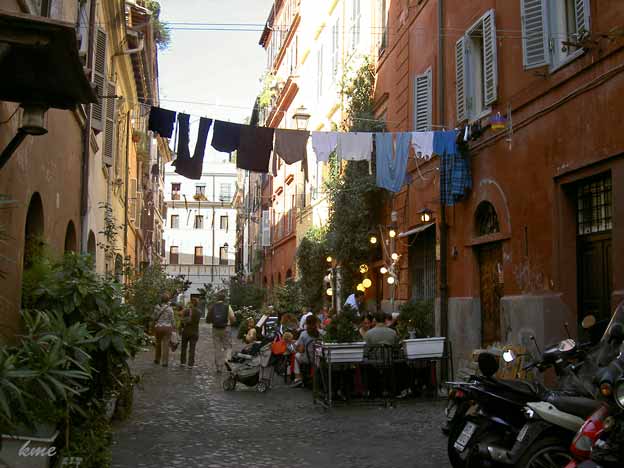 Gate i Trastevere Trastevere er en stor attraksjon hele året på grunn av restaurantene, klubben og kinoene, men også på grunn av den pittoreske labyrinten av smale, brosteinsbelagte gater og smug. (19.10.2008) |
||||||
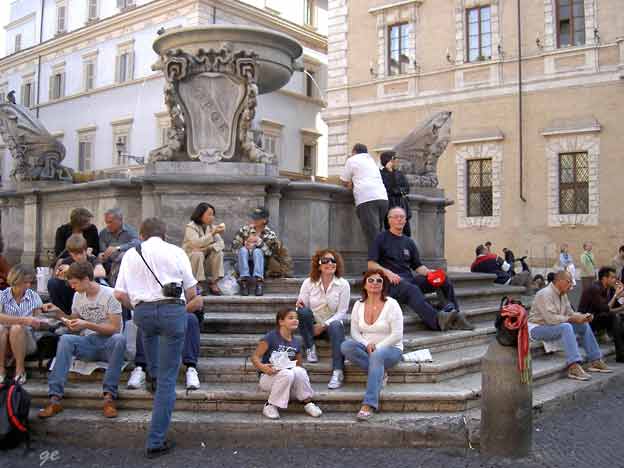 Piazza Santa Maria in Trastevere, møteplassen for backpackere. (19.10.2008) |
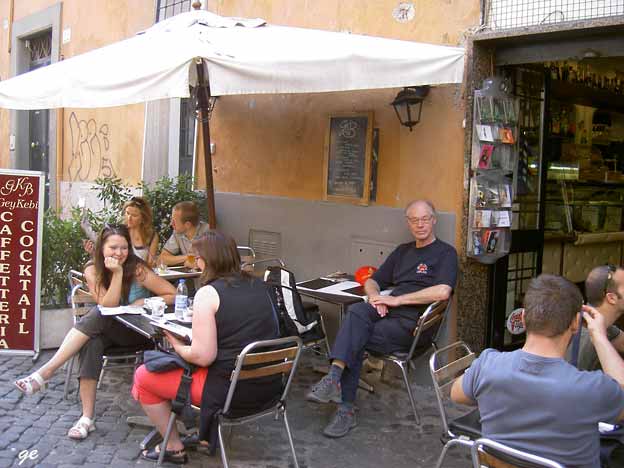 Det er mange små kafeer i Trastevere. Her venter Karl Martin på servering. (19.10.2008) |
||||||
|
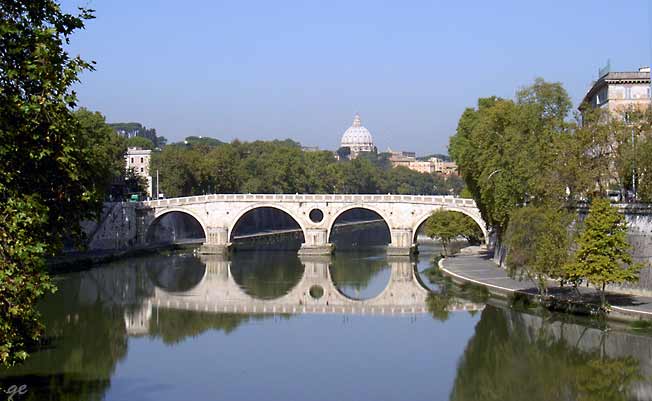 Ponte Sisto over Tevere med Peterskirken i bakgrunnen (2.10.2007) |
||||||
| Bydel Campo de Fiori (17.10.2008) | |||||||
|
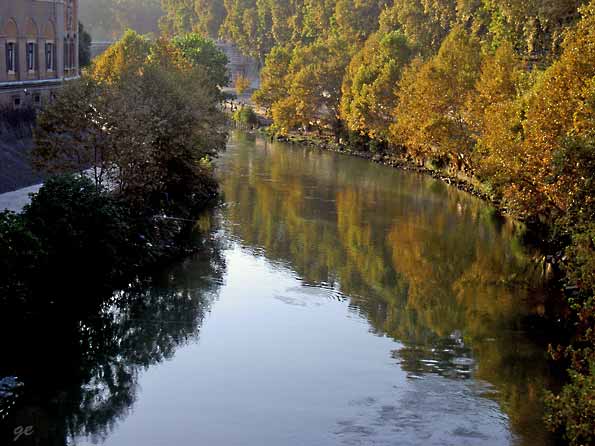 Tevere i Roma Elva er 405 km lang. Den kommer fra Appenninene og renner ut i Middelhavet ved Ostia, Romas havneby. (18.10.2008) |
||||||
island in the Tiber river which runs through Rome. Tiber island is located in the southern bend of the Tiber. The island is boat-shaped, approximately 270 m long and 67 m wide, and has been connected with bridges to both sides of the river since antiquity. Being a seat of the ancient temple of Asclepius and later a hospital, the island is associated with medicine and healing. The island has been linked to the rest of Rome by two bridges since antiquity, and was once called Insula Inter-Duos-Pontes which means "the island between the two bridges". The Ponte Fabricio, the only original bridge in Rome, connects the island from the northeast to the Field of Mars in the rione Sant'Angelo (left bank). The Ponte Cestio, of which only some original parts survived, connects the island to Trastevere on the south (right bank). http://en.wikipedia.org/wiki/Tiber_Island |
 Ponte Fabbricio Broa ble bygd i 62 f. Kr. og er den eldste broa over Tevere som fremdeles er i bruk. (2.10.2007) |
||||||
 |
Republican Roman temples, and the remains of Pompey's Theatre. It is located in the ancient Campus Martius. The name of the square comes from the Torre Argentina, which takes its name from the city of Strasbourg, whose Latin name was Argentoratum. In 1503, the Papal Master of Ceremonies Johannes Burckardt, who came from Strasbourg and was known as "Argentinus", built in via del Sudario a palace (now at number 44), called Casa del Burcardo, to which the tower i annexed. http://en.wikipedia.org/wiki/Largo_di_Torre_Argentinas
|
||||||
| Bydel:
Aventin Aventinerhøyden (latin Mons Aventinus) er en av Romas sju høyder, beliggende sørvest for Palatinerhøyden ved Tiberen. Under den romerske republikken var kollen en folkelig bydel, bebodd av plebeiere, men kom seinere å bli et eksklusivt bostedsområde med store villaer, templer og luksuriøse badeinrettninger. På Aventinerhøyden blei det feira blant annet ekstatiske fester til ære for Bacchus. I løpet av middelalderen blei Aventinerhøyden avfolka og den har fram til i dag blitt dominert av klostre og hager. Til Aventinerhøydenss mer kjente bygninger regnes kirkene Santa Sabina, Sant'Alessio, Santa Prisca fra tidlig kristendom, samt den moderne kirken Sant'Anselmo. Dessuten bør man nevne Malteserordenens sete og dens kirke Santa Maria del Priorato. På Lille Aventinerhøyden ligger blant annet kirken San Saba. Blant Aventinerhøydens antikke levninger kan nevnes Dianas tempel, samt rester av Serviusmuren. http://no.wikipedia.org/wiki/Aventinerh%C3%B8yden |
|
||||||
| Bydel Capitol The Capitoline Hill (/ˈkæpɨtəlaɪn/ or /kəˈpɪtɵlaɪn/; Latin: Collis Capitōlīnus), between the Forum and the Campus Martius, is one of the seven hills of Rome. It was the citadel (equivalent of the ancient Greek acropolis) of the earliest Romans. The name capitol seems to have meant "dominant height", although ancient tradition places its origin in caput ("skull": a specific skull found while laying the Temple of Jupiter foundation). By the 16th century, Capitolinus had become Capitolino in Italian, with the alternative Campidoglio stemming from Capitolium, one of the three major spurs of the Capitolinus (the others being Arx and Tarpeius). The English word capitol derives from Capitoline. The Capitoline contains few ancient ground-level ruins, as they are almost entirely covered up by Medieval and Renaissance palaces (now housing the Capitoline Museums) that surround a piazza, a significant urban plan designed by Michelangelo. http://en.wikipedia.org/wiki/Capitoline_Hill |
 Karl Martin på Capitol Huset er Palazzo Senatorio. Det ble brukt av det romerske senatet fra rundt 1100-tallet. I dag inneholder det kontorene til borgermesteren. Trappa heter Cordonata og er tegnet av Michelangelo. (1.10.2007) |
||||||
|
|
||||||
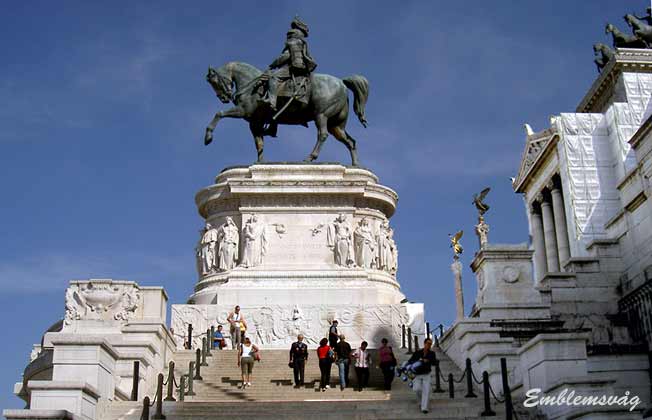 Victor Emmanuel monomentet. Bygget ble innviet i 1911 til ære for Victor Emmanuel II av Savoia, den første kongen i et samlet Italia. (1.10.2007) |
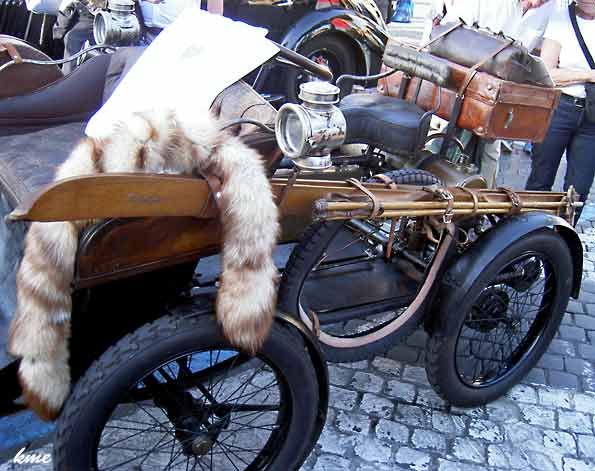 Veteranbilutstilling ved Victor Emmanuelmonumentet. Her står en Ferrari 1904 ferdig pakket for skitur. (18.10.2008) |
||||||
Bydel Forum Forum Romanum var sentrum for Romas religiøse og offentlige liv med senatet, domstoler og templer liggende lang datidens mest berømte gate, Via Sacra. Det var langs Via Sacra triumftogene opp til Kapitol fant sted. Forum Romanum ligger i
dalen mellom Kapitol og Palatin, og her
|
 Forum Romanum Forum Romanum med Palatinerhøyden i bakgrunnen. På Palatinhøyden ligger ruinene av Domus Flavia og Domus Augustana og to deler av Domitians enorme palass fra slutten av det første århundre e.Kr. 1.10.2007) |
||||||
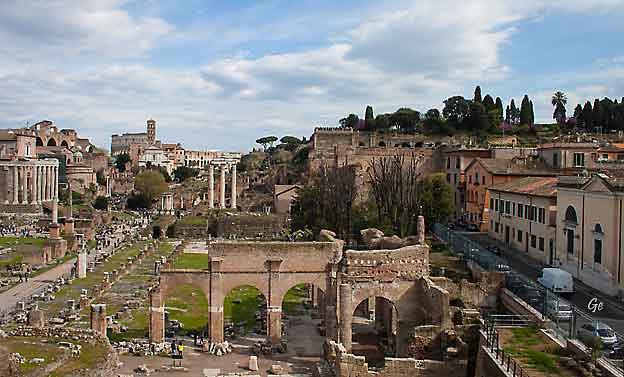 Forum Romanum sett fra Capitol (april 2015) |
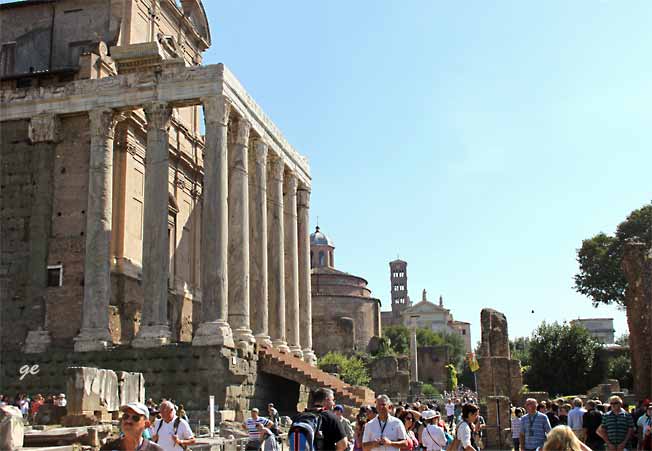 Forum var sentrum for det politiske, kommersielle og juridiske livet i det gamle Roma. (27.9.2013) |
||||||
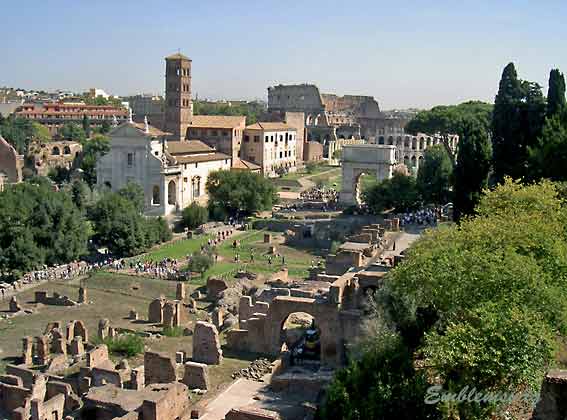 Forum Romanum 1.10.2007 |
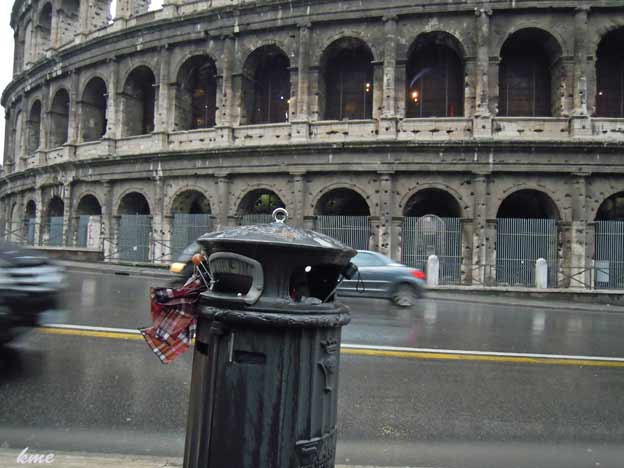 Colosseum en dag med regn og vind. Colosseum ble bygd av keiser Vespasian i år 72 e.Kr. (bilde 9.3.2010) |
||||||
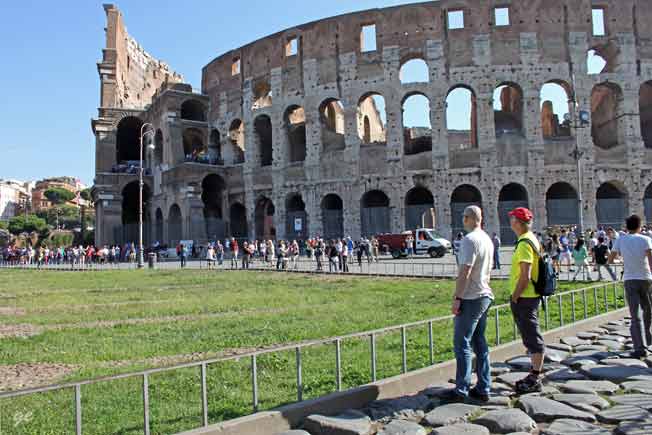 Geir og Karl Martin utenfor Colosseum. (27.9.2013) |
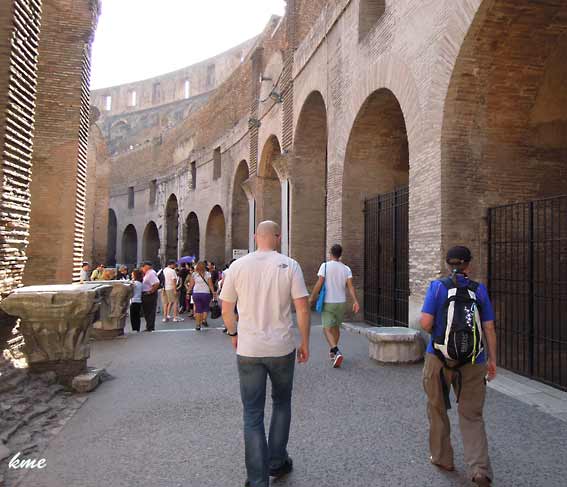 Geir og Grete på Colosseum (27.9.2013) |
||||||
|
|
||||||
 Konstantinbuen ved Colosseum Buet ble innviet i 315 e.Kr for å feire Konstantins seier tre år tidligere over hans medkeiser Maxentius. (1.10.2007) |
 Trajans marked Markedet ble i sin tid regnet blant underverkene i den klassiske verden. Keiser Trajan og hans arkitekt Apollodorus fra Damaskus bygde dette visjonære nye komplekset med 150 butikker og kontorer tidlig på 100-tallet e.Kr. (1.10.2007) |
||||||
|
|
|
||||||
| Bydel
Palatin The Palatine Hill (Latin: Collis Palatium or Mons Palatinus; Italian: Palatino, IPA: [päläˈt̪iːno]) is the centermost of the Seven Hills of Rome and is one of the most ancient parts of the city. It stands 40 metres above the Forum Romanum, looking down upon it on one side, and upon the Circus Maximus on the other. It is the etymological origin of the word "palace" and its cognates in other languages (Italian "Palazzo", French "Palais", German "Palast", etc.) According to
Roman mythology, the Palatine Hill was the
location of the cave, known as the Lupercal, where
Romulus and Remus were found by the she-wolf Lupa
that kept them alive. According to this legend,
the shepherd Faustulus thereafter found the
infants, and with his |
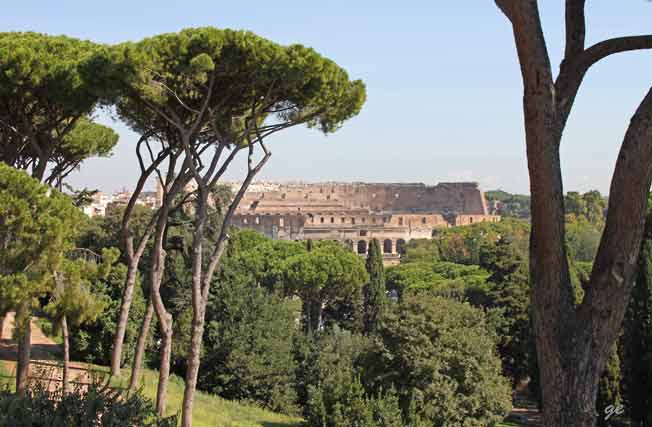 Fra Palatin mot Colosseum (27.9.2013) |
||||||
Santa Anastasia was built in the late 3rd century - early 4th century, possibly by a Roman woman named Anastasia. The church is listed under the titulus Anastasiae in the acts of the 499 synod. Later the church was entitled to the martyr with the same name, Anastasia of Sirmium. The church was restored several times: Pope Damasus I (366-383), Pope Hilarius (461-468), Pope John VII (705-707), Pope Leo III (795-816), and Pope Gregory IV (827-844). The current church dates back to the 17th century restoration commissioned by Pope Urban VII. Traditionally, the church is connected to the cult of St Jerome, who possibly celebrated mass here. The saint is depicted over the altar, by Domenichino. The last restoration, after the restoration during the papacy of Sixtus IV, occurred in 1636, when the facade, with lower doric and upper ionic order, was reconstructed in 1636, after the cyclone of 1634. The nave recycles antique columns. The ceiling is frescoed with a martyrdom of the saints (1722) by Michelangelo Cerruti.The chapel to the right, has a painting of St. John the Baptist by Pier Francesco Mola. While the last chapel on the right has a fresco of Scenes of the life of Saints Carlo Borromeo and Filippo Neri by Lazzaro Baldi. The right transept has a painting of S.Toribio (1726) by Francesco Trevisani. The high altar has a Nativity by Lazzaro Baldi and below the altar is a statue of Saint Anastasia by Ercole Ferrata. It clearly shows the influence of Bernini's Beata Ludovica Albertoni. http://en.wikipedia.org/wiki/Basilica_di_Sant'Anastasia_al_Palatino |
|
||||||
| Bydel
Caracalla Celianhøyden har utsikt over Colosseum og har sitt navn etter Caelius Vibenna, den legendariske helten fra kampen mot tarquinerne (omkr år 600 f. Kr). I keisertiden var det et fasjonabelt boligstrøk, og noe av den gamle prakten er fremdeles tydelig i de kjempestore ruinene av Caracallas termer. |
Takket være den arkeologiske sonen som ble opprettet tidlig på 1900-tallet, er det herlig fredelig område, en grønn lunge fra Aurelians mur til sentrum av byen. Den brosteinsbelagte Via di Porta San Sebastiano-delen av den gamle Via Appia går gjennom området. Den fører til Porta San Sebastiano, en av de best bevarte portene i den gamle bymuren. (Bilder under Via Appia) Fra Gyldendahls reiseguider, Roma |
||||||
|
|
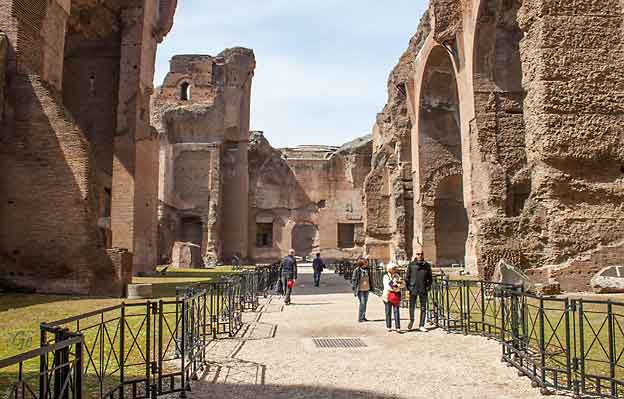 Caracallas termer april 2015 As well as the baths, there were spaces for exercise, libraries, art galleriesand gardens - a true leisure centre. Most of the rich marble decorations of the baths were removed by the Farnese family in the 16th century to adorn the interior of Palazzo Farnese. http://www.italyguides.it/en/lazio/rome/ancient-rome/baths-of-caracalla |
||||||
|
Santi Giovanni e Paolo is an ancient basilica church in Rome, located on the Celian Hill. It is also called Santi Giovanni e Paolo al Celio or referred to as SS Giovanni e Paolo. The church was built in 398, by will of senator Pammachius, over the home of two Roman soldiers, John and Paul, martyred under Julian in 362. The church was thus called the Titulus Pammachii and is recorded as such in the acts of the synod held by Pope Symmachus in 499. The church was damaged during the sack by Alaric I (410) and because of an earthquake (442), restored by Pope Paschal I (824), sacked again by the Normans (1084), and again restored, with the addition of a monastery and a bell tower. It is home to the Passionists and is the burial place of St. Paul of the Cross. Additionally, it is the station church of the first Friday in Lent. https://en.wikipedia.org/wiki/Santi_ Giovanni_e_Paolo,_Rome |
||||||
|
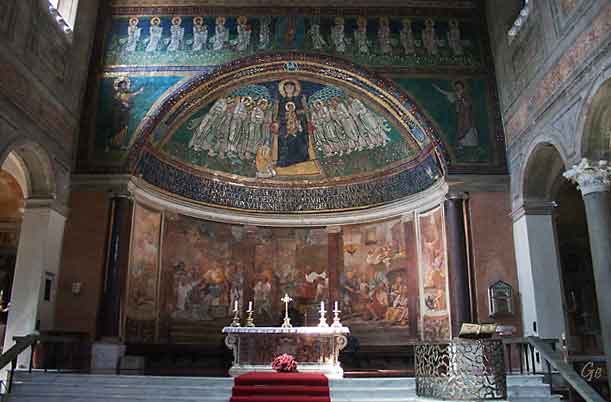 Santa Maria in Domnica Vi var der april 2015 The church was built in ancient times, close to the barracks of the 5th Cohort of the Roman Vigiles on the Caelian Hill. The church is mentioned in the records of a synod held by Pope Symmachus in 499. In the year 678, it was one of seven churches assigned to deacons by Pope Agatho. The church was rebuilt from 818-822 by Pope Paschal I, who is credited with Rome's early 9th century age of renovation and artistic splendour, had the church rebuilt in 818-822, providing it with noteworthy mosaic decoration. The interior of the church was extensively modified in the 16th century by the Medici family, who were the cardinal holders of the archdiaconate through much of this period. In 1513, Cardinal Giovanni di Lorenzo de' Medici, shortly before he became Pope Leo X, with Andrea Sansovino added the façade portico with Tuscan columns and the fountain. He was followed by Giulio di Giuliano de 'Medici, the future Pope Clement VII from 1513-1517. Giovanni de' Medici became cardinal-deacon at the age of 17 in 1560, but died in 1562. He was followed by his brother Ferdinando I de' Medici, who also became Grand Duke of Tuscany. He added the coffered ceiling of the basilica during his tenure. http://en.wikipedia.org/wiki/Santa_Maria_in_Domnica |
||||||
Laterano I middelalderen var Lateranpalasset paveresidens, og prakten i basilikaen San Giovanni ved siden av var på høyde med Peterskirkens. Etter pavenes tilbakekomst fra Avignon mot slutten av 1300-tallet mistet området sin betydning. Pilegrimene forsatte å besøke San Giovanni og Santa Croce in Gerusalemme, men området fortsatte å være ganske tynt befolket. Gamle klostre slumret blant hager og vinmarker helt frem til Roma ble Italias hovedstad i 1870 og området ble regulert med et nettverk av boliggater for å ta imot den store strømmen av nykommere. Den arkeologiske interessen er særlig knyttet til Aurelians mur og ruinene av Neros akvedukt. Fra Gyldendahls reiseguider, Roma |
illustrious and devoted men and women before him, Pope Pius IX climbed the stairs many times throughout his lifetime, until the eve of the capture of Rome and his voluntary reclusion in the Vatican in 1870. The Sanctuary, as part of the Holy See, according to the 1929 Lateran pact between Mussolini and the Roman Catholic Church, has the all the rights of extraterritoriality. The Holy Stairs | Santuario della Scala Santa e Sancta Sanctorum (scala-santa.com) (26. april 2022) |
||||||
|
|
||||||
| I
Lateran har vi også vært i Santa Croce in Gerusalemme. The Basilica of the Holy Cross in Jerusalem is in Rome, in Esquilino neighbourhood, at the vertex of three street: street Carlo Felice, street Santa Croce in Gerusalemme and street Eleniana. The church is one the Seven Pilgrims Churches of Rome. Between the III and IV century a.C. the emperor Costantine and his mother Helena adapted a large room in the imperial palace Sessorium to be a church. That's the reason why Santa Croce is also called Basilica Heleniana or Sessoriana. In VIII century the basilica was restored by pope Gregorio II and Adriano I, but in XII century, with pope Lucio II underwent a radical modification, according to the Romanesque style, with the subdivisions in three parts, a nave and two aisles, and the adding of a belfry and porch, the latter no more existing. The current appearance is from XVIII century, under the reign of Pope Benedetto XIV, who was, before his election, the cardinal priest of the basilica. Architects Pietro Passalacqua and Domenico Gregorini built a late Baroque façade and an elliptical atrium. From 1370 to 1561 a Chartusian monastery was next to the basilica. Basilica of the Holy Cross in Jerusalem - Rome (santacroceroma.it) (26. april 2022) |
vi har
også sett "bakerens grav" The tomb of Marcus Vergilius Eurysaces the baker is one of the largest and best-preserved freedman funerary monuments in Rome. Its sculpted frieze is a classic example of the "plebeian style" in Roman sculpture. Eurysaces built the tomb for himself and perhaps also his wife Atistia around the end of the Republic (ca. 50-20 BC). http://en.wikipedia.org/wiki/Tomb_of_Eurysaces_the_Baker |
||||||
Bydel Esquilin I September 2013 bodde vi på hotel Champagne Palace. Hotellet ligger like ved Termini og med gangavstand til de fleste mest kjente severdigheter. Et helt greit hotellet. Spisesalen ligger i 7. etasje med fin utsikt over Roma. (Bildet er tatt 23.9.2013) April 2015 bodde vi på det samme hotellet. |
Esquilin er den største og høyeste av Romas syv høyder. I keisertiden var de vestlie skråningene med utsikt over Forum dekket av det overfylte slumområdet Suburra. På østsiden var det noen få villaer som ble eid avav slike velstående borgere som Maecenas, som var kunstmesen og rådgiver for Augustus. Stedet har beholdt det grunnleggende preget gjennom to årtusener, og det er fremdeles et av de fattigere kvarterene i byen. I dag er området sterkt utbygd, bortsett fra en temmelig lurvete park på Colle Oppio, en mindre høyde sør for Esquilin. Der kan du se restene av badene til Titus, badene til Trajan og Domus Aurea, Neros gylne hus. Men det som er mest interessant i bydelen, er kirkene. Mange av dem er blitt bygd på tomtene til private hus der de kristne møttes til hemmelige gudstjenester på den tiden da religion var forbudt. (Gyldendals reiseguider) |
||||||
|
|
Built on a pagan temple dedicated to the goddess Cybele, the Basilica of Santa Maria Maggiore was built in the mid-fourth century under the orders of Pope Liberius. According to legend, the Virgin appeared before the Pope with the instructions for building the church, and the shape of the floor was designed based on a miraculous snowfall. Over the years, the basilica has had many different names, such as Saint Mary of the Snow (due to snow that led to the church’s shape), Santa Maria Liberiana (for Pope Liberius), St. Mary of the Nativity (because it received a relic of the Holy Nativity), and it was finally called Santa Maria Maggiore, as it is the largest of the 26 churches in Rome dedicated to the Virgin Mary. Probably the most striking aspect of the Basilica Santa Maria Maggiore is the different parts belonging to such varied periods of history. As if it were made up of remnants, the church summarizes the most important stages of Christian art in Rome. Basilica di Santa Maria Maggiore - The ancient church in Rome (26. april 2022) |
||||||
Villa Borghese er i utkanten av Roma I Villaen er det nå galleri. Parken ble anlagt av kardinal Scipione Borghese. Han fikk huset bygget for adspredelser og underholdning. Scipione åpnet også sin fornøyelsespark for publikum. Kardinalen var også en ekstravagant beskytter av kunsten, og skulpturene han bestilte fra den unge Bernini, rangerer nå blant hans mest berømte arbeider. (3.10.2007)
|
 Borghese-parken 3.10.2007 |
||||||
Andre kunstnere som er nevnt: Giuvanni Bellini, født ca 1430 Da vi var i Roma i 2008 var det utstilling av Bellinis verker på Scuderie del Quirinale Jeg har nevnt Berninis navn flere ganger. Her er mer om ham. Giovanni Lorenzo Bernini |
|
||||||
|
 Den gamle bymuren ved porta San Sebastiano. |
||||||
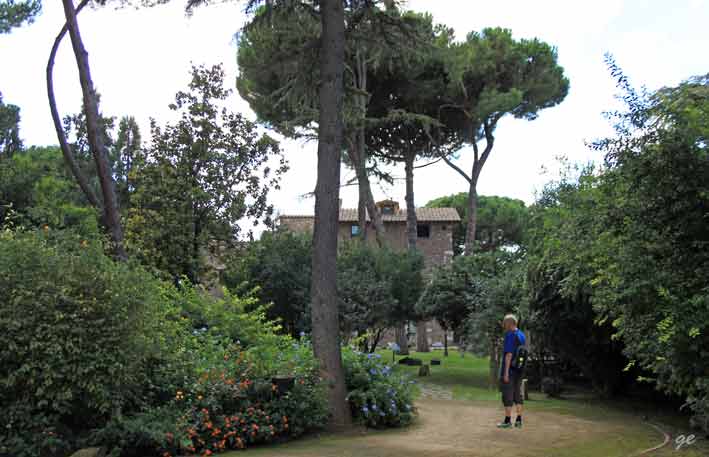 På Via Appia Antica ligger Capo di Bove. Et arkeologisk område og en pen park med skulpturer. (25.9.2013) |
|
||||||
Vi besøkte også Celias grav, It was built during the 1st century B.C to honor Caecilia Metella who was the daughter of Quintus Caecilius Metellus Creticus, a Consul in 69 B.C, and wife of Marcus Licinius Crassus, son of the famous Marcus Crassus who served under Julius Caesar. http://en.wikipedia.org/wiki/Tomb_of_Caecilia_Metella og kirkene San Sebastian og Built originally in the first half of the 4th century, the basilica is dedicated to St. Sebastian, a popular Roman martyr of the 3rd century. The name ad catacumbas refers to the catacombs of St Sebastian, over which the church was built, while "fuori le mura" refers to the fact that the church is built outside the Aurelian Walls, and is used to differentiate the basilica from the church of San Sebastiano al Palatino on the Palatine Hill http://en.wikipedia.org/wiki/San_Sebastiano_fuori_le_mura Quo Vadis The church of the “Domine Quo Vadis” is one of the first churches located on the Via Appia Antica, about 800 meters beyond Porta San Sebastiano. The Church has medieval origins, but was rebuilt in 1600. It takes its name from the oral tradition according to which the apostle Peter, fleeing from the city to avoid martyrdom, meets Jesus to whom he addresses the following words “Domine quo vadis (Lord, where are you going)?” And the Lord replied “Venio Romam iterum crucifigi (I am coming to Rome to be crucified again)”. Peter, aware of the rebuke, turns back to face his destiny and Jesus disappears but, in disappearing, he leaves the impressions of his footprints on the road. As evidence of the incident, within the Church there is a stone with the imprints “of His holy feet”, left by Jesus precisely on the site where the Church now stands. The stone is actually a copy: the original is in fact preserved in the Basilica of San Sebastiano. The second name with which the church is known: Santa Maria “in Palmis” derives from this episode. CHIESA DOMINE QUO VADIS (26. april 2022) |
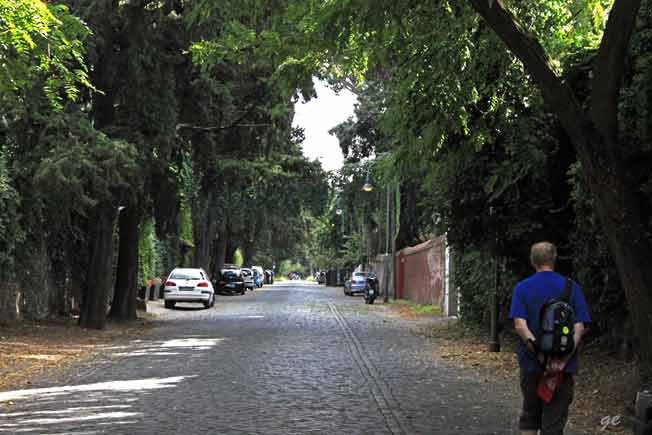 Rusling langs Via Appia Antica.(25.9.2013) På vei til Via Appia gikk vi gjennom Porta San Sebastian Porta San Sebastiano is the biggest and one of the best preserved gates in the Aurelian Walls in Rome (Italy). Its previous name, kept for a long time, was Porta Appia, as the gate was crossed by the Appian Way, the regina viarum, that started, just a little farther, from Porta Capena in the Servian Wall. During the Middle Ages probably it was also calles Accia (or Dazza or Datia), a name whose etymology is quite uncertain, but arguably associated with the little river Almone, called "acqua Accia", that flowed nearby. A document dated 1434 calls it Porta Domine quo vadis. The present name is attested only since the second half of 15th century, due to the vicinity to the Basilica of San Sebastiano and its catacombs. http://en.wikipedia.org/wiki/Porta_San_Sebastiano 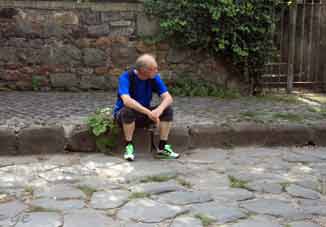 Vi venter på buss tilbake til sentrum (25.9.2013) |
||||||
|
|
||||||
Utflukter ut av Roma: oktober 2008: Tivoli mars 2010: Ostia Antica og Ostia Lido september 2013: Firenze 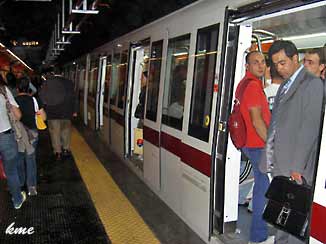
I 2010 tok vi en tur til Ostia Antica og Ostia Lido. Det er ca 1/2 time med metro og tog. |
Ostia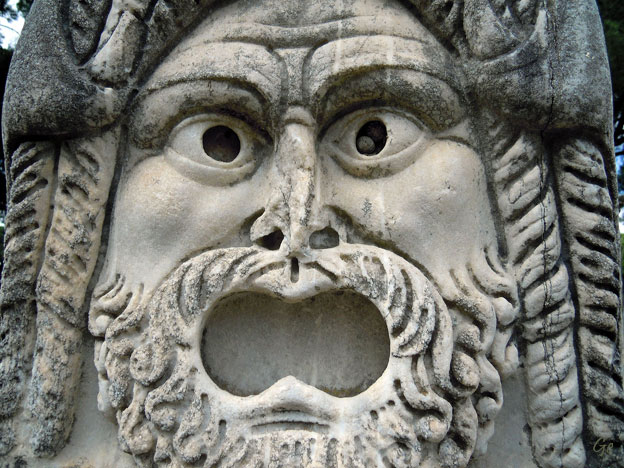 Maske i Ostia Antica (11.3.2010) |
||||||
I republikkens tid var Ostia Antica Romas viktigste kommersielle havn og en militærbase som forsvarte kystlinjen og utlæpet av Tevere. Havnebyen fortsatte å blomstre gjennom hele keisertiden, til tross for Portus, den nye havnen som på 100-tallet ble anlagt litt lenger mot nordvest. |
 Ostia Antica (11.3.2010) |
||||||
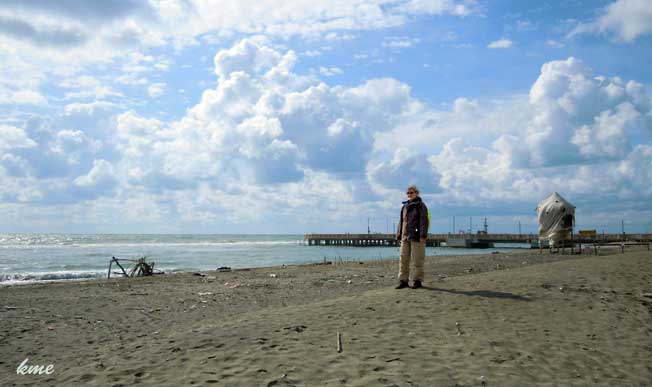 Romas Lido. Ikke langt fra Ostia Antica ligger Romas strandområde, Ostia Lido. Flott strand, men det var litt for kaldt til å bade da vi var der. (11.3.2010) |
 |
||||||
well-known "tourist port" with moorings for boats from 8-60 metres (26-197 ft) in length. It also contains many Roman ruins, dating back to the days when Ostia served as Rome's port (a function now taken over by Civitavecchia). Ostia Antica is one of Lazio's major attractions, less crowded and, for some, more enjoyable than the ruins of Pompeii. So if you can't make it down to Pompeii, don't worry: just head out to Ostia antica. Italy might be a Catholic country, but you won't detect any religious conservatism in the skimpy bikinis on display here. There's a carnival atmosphere with dance halls, cinemas, and pizzerias. The Lido is set off best at Castelporziano, against a backdrop of pinewoods which provide the summer residence of the President of Italy. This stretch of shoreline is referred to as the Roman Riviera. http://wikitravel.org/en/Ostia |
Tivoli Tivoli, Hadrians villa i Tivoli |
||||||
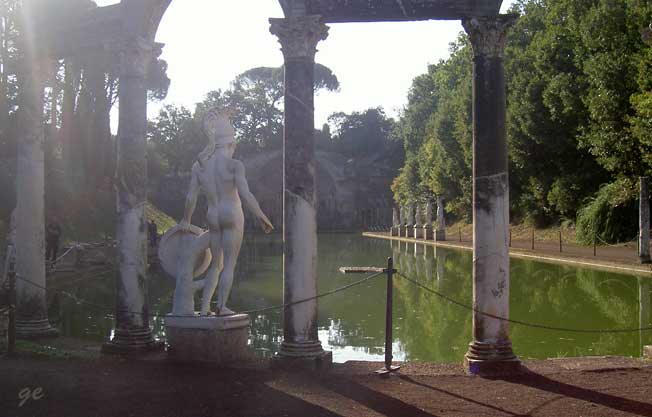 I 2008 tok vi en tur til Tivoli. Der besøkte vi Hadrians Villa og Villa d´este Bildet
over er fra Hadrians villa |
|
||||||
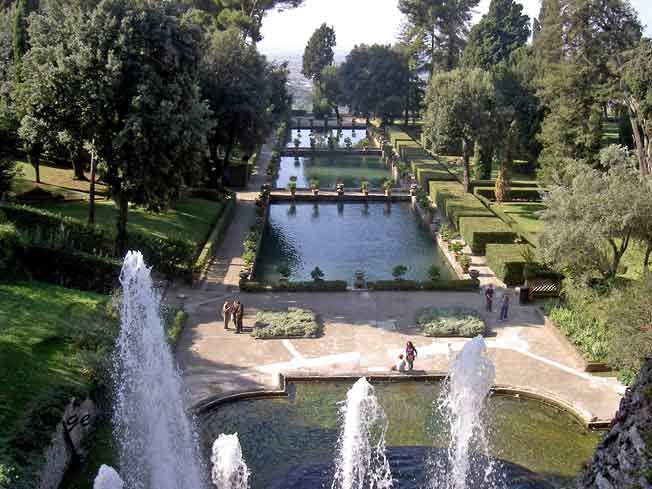 Hagen til Villa d´este. (18.10.2008) |
 Fontene i Villa d´este i Tivoli (18.10.2008) Fontene i Villa d´este i Tivoli (18.10.2008) |
||||||
| Årets (2013) ut
av Romatur gikk til Firenze I 2015 ble det en ny tur til Firenze. Denne gangen ble vi i byen tre netter Firenze (latin Florentia) er en by i provinsen med samme navn, og byen er regionshovedstad i Toscana i det nordlige Italia. Navnet kommer avlatin: Florentia som betyr den blomstrende. Fra 1865 til 1870 var byen også hovedstad i Kongedømmet Italia. Firenze ligger ved elven Arno, som ligger på en slette ved foten av fjellkjeden Appenninene. Den har omkring 400 000 innbyggere, innbefattet en forstadsbefolkning på i overkant av 200 000 mennesker. http://no.wikipedia.org/wiki/Firenze |
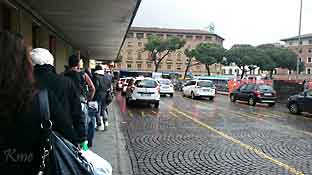 I 2013 var det litt for varmt, i 2015 var det kaldt og regn da vi kom til Firenze |
||||||
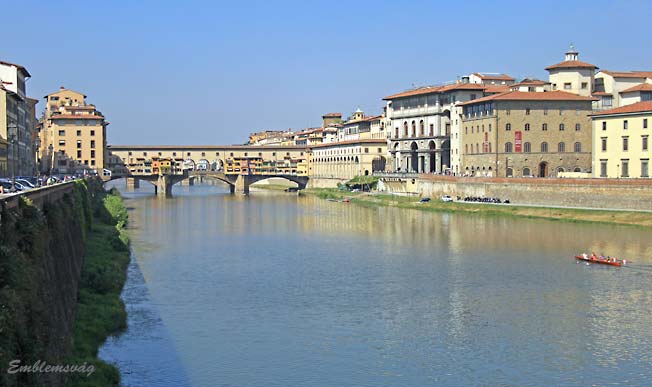 |
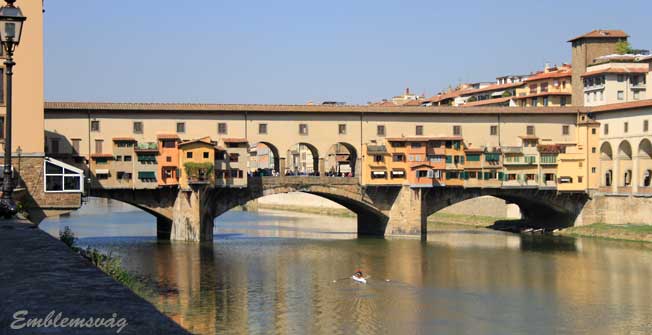 To bilder av Ponte Veccio, Firenze (24.9.2013) |
||||||
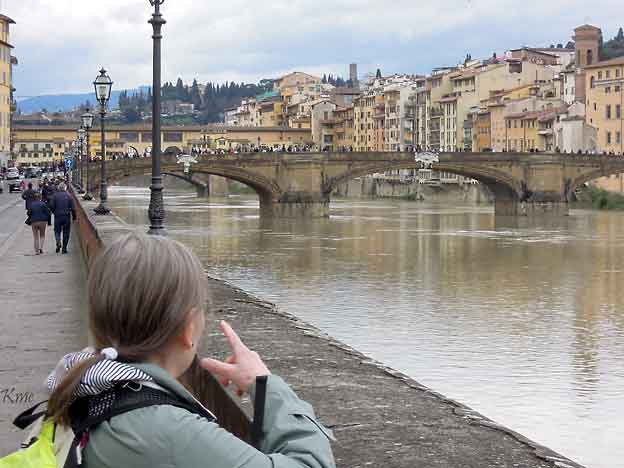 To broer over Arno. Den bakerste er Ponte Vecchio (5.4.2015) |
 Ponte Vecchio og husrekka på sørsiden av elva (5.4.2015) |
||||||
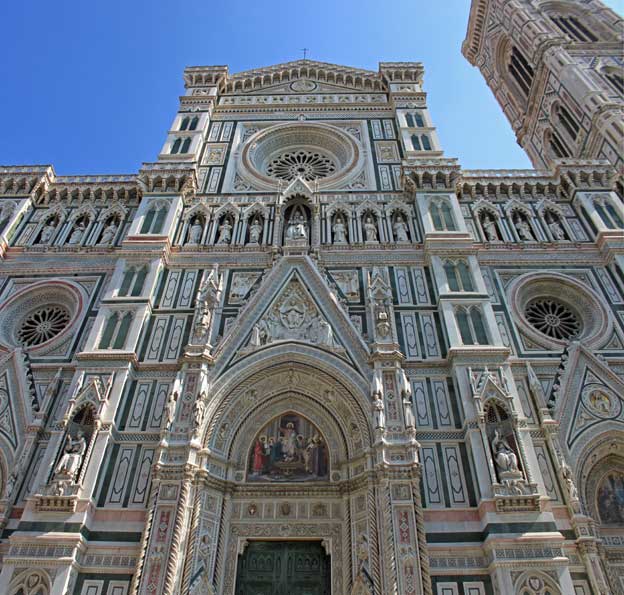 Domkirken i Firenze (24.9.2013 The first stone of the new cathedral was laid on 8 September 1296, and the task of erecting it was entrusted to Arnolfo di Cambio. His project was similar in plan but smaller than the current building, which instead corresponds to the expansion developed by Francesco Talenti, beginning in the mid-14th century. The church was consecrated at completion of the dome, by Pope Eugenio IV, on 25 March 1436. The Cathedral of Santa Maria del Fiore | The Opera del Duomo (20. januar 2024) |
On Easter Sunday every year, Florence celebrates the religious holiday in a very special way. The Scoppio del Carro, or the "Explosion of the Cart", dates back over 350 years. An elaborate wagon built in 1622 and standing two to three stories high is pulled by a pair of oxen decorated in garlands through the streets of Florence to the square between the Baptistry and Cathedral. This tradition finds its origins in events that are partly historic and partly legendary. A young Florentine named Pazzino, a member of the noble Pazzi family, apparently took part in the First Crusade in the Holy Land in 1099, where he gave ample proof of his courage (he was the first to scale the walls of Jerusalem and raise the Christian banner). When he came home, he brought back three flints from the Holy Sepulchre that he received for his act of courage. This reliquary, today preserved in the Church of SS. Apostoli, lies behind the Florentine celebration for the Resurrection of Christ. Today, the ceremony still bears a strong resemblance to the way in which it has been celebrated for centuries. Starting around 10am, a priest rubs Pazzino’s three flints together until they spark and light the Easter candle; this, in turn, is used to light some coals which are placed in a container on the Cart and the procession delivers the Holy Fire to the Archbishop of Florence before Santa Maria del Fiore, better known as the Duomo. The cart is accompanied by drummers, flag throwers and figures dressed in historical costume as well as city officials and clerical representatives. http://www.visitflorence.com/florence-events/explosion-of-the-cart-easter.html |
||||||
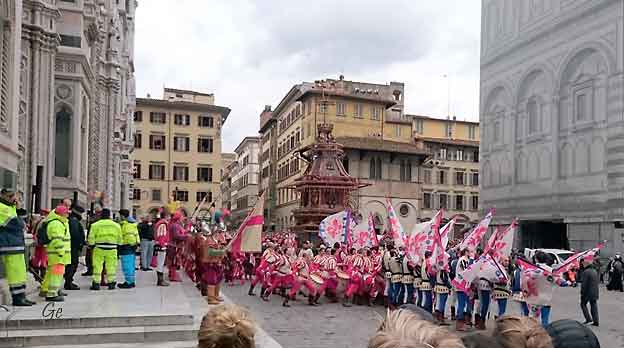 Vogna er kjørt fram, snart begynner fyrverkeriet. (5.4.2015) |
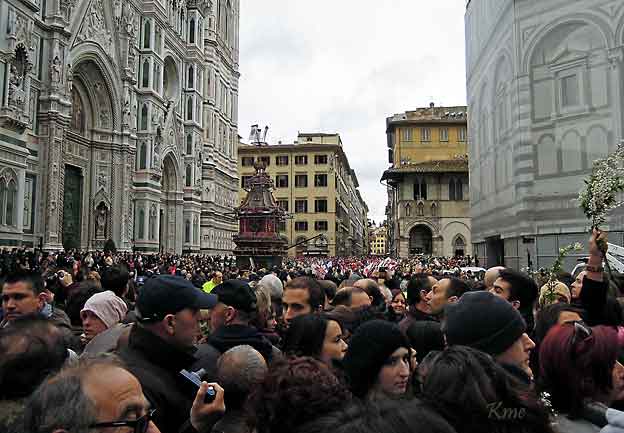 Folk strømmer til Domkirkeplassen fra alle sidegater. (5.4.2015) |
||||||
|
|
||||||
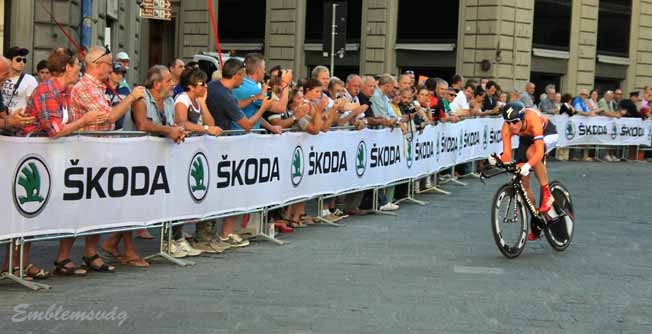 Sykkel-VM i Firenze 2013 Dette er siste startende i dagens løp. (24.9.2 |
The Gates of Paradise is the main gate of the Baptistry of Florence (Battistero di San Giovanni), located in front of the Cathedral of Santa Maria del Fiore. The Porta del Paradiso, in Italian, was created by Florentine goldsmith and sculptor Lorenzo Ghiberti between 1425 and 1452 and installed in the eastern portal of the Baptistery. The Gates have been praised by generations of artists and art historians for their compelling portrayal of scenes from the Old Testament. Over time, the seventeen-foot-tall, three-ton bronze doors became an icon of Renaissance, one of the most famous works of art in the world.The workmanship of panels demonstrates that the Florentine artists had mastered linear perspective and the classical idiom by the early 15th century. According to The Lives of the Artist by Giorgio Vasari, the door—once known just as the East Door—was named the Gates of Paradise by Michelangelo Buonarroti because of its striking beauty. https://www.florenceinferno.com/gates-of-paradise/ (29.8.2019 |
||||||
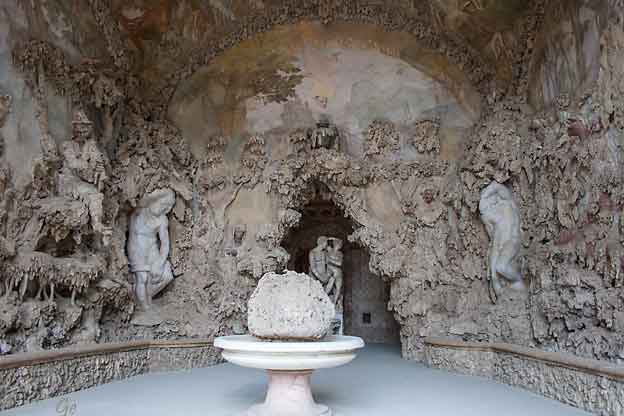 Giardino di Boboli, grotta (6.4.2015) Decorated internally and externally with stalactites and originally equipped with waterworks and luxuriant vegetation, the Large Grotto is divided into three sections decorated with remarkable examples of Mannerist sculptures. The first one was frescoed to create the illusion of a natural grotto, a natural refuge for shepherds to protect themselves from wild animals. It originally housed The Prisoners by Michelangelo which are now in the Accademia Gallery. The third and furthest hall in the grotto contains Giambologna's famous Bathing Venus and the second section contains Paris and Helen by Vincenzo de' Rossi. These last two chambers were created as the perfect setting for the secretive, amorous meetings of the Duke Francesco I de’ Medici. http://www.visitflorence.com/florence-museums/boboli-gardens.html |
|
||||||
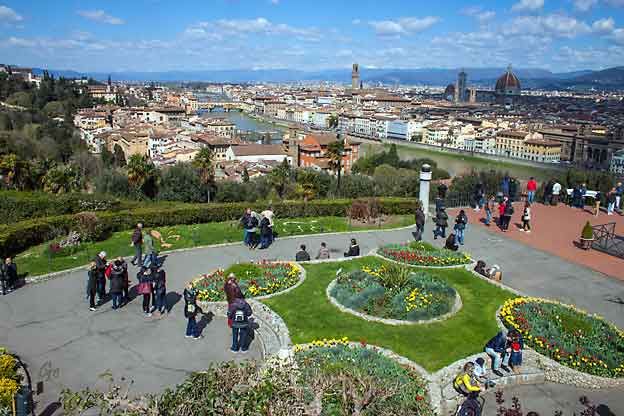 Utsikt fra Piazzale Michelangelo (6.4.2015) |
 Utsikt fra Piazzale Michelangelo (6.4.2015) Designed in 1869 by Florentine architect Giuseppe Poggi, Piazzale Michelangelo offers panoramic views of Florence and the Arno valley and is a popular spot with locals and tourists. http://www.visitflorence.com/florence-monuments/piazzale-michelangelo.html |
||||||
Chianti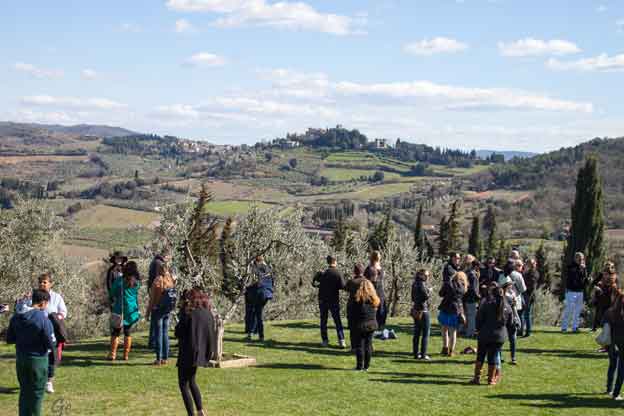 Chiantiområdet i Toscana. Bildet er tatt fra vingården Panzanello 6.4.2015 |
The Chianti area in Tuscany is one of the most beautiful in the whole region, as well as the most well-known and appreciated by visitors from across the world. The borders of the Chianti region are not clearly defined but in general it extends over the provinces of Florence and Siena, covering all of the area between the two cities and extending to the east toward the Valdarno and to the west to the Val d'Elsa. The Chianti wine area extends further beyond the two cities, all around Florence and even toward Arezzo, Pistoia and Montepulciano. http://www.chianti.com/ |
||||||
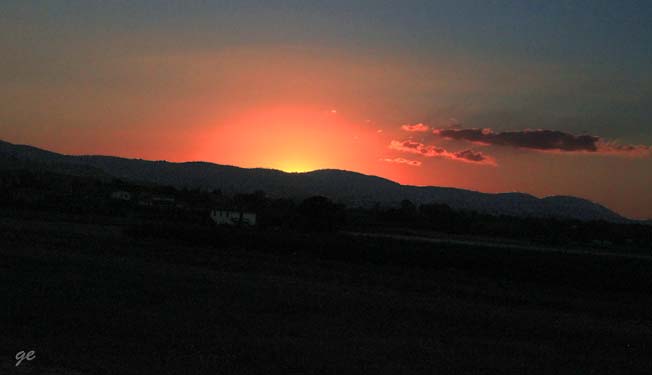 Solnedgang i Toscana 2013 |
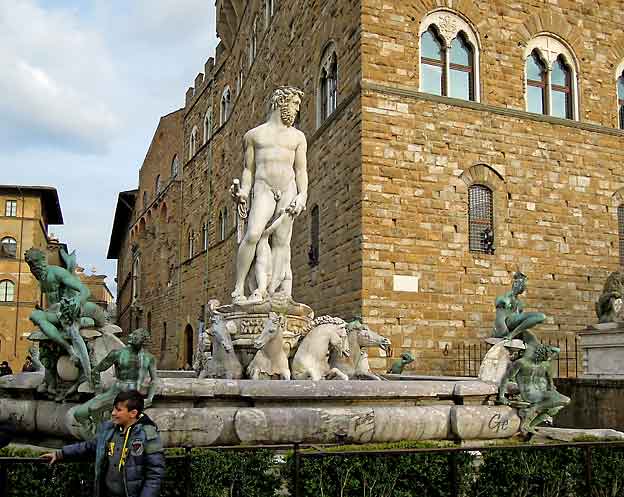 På Piazza della Signoria 5.4.2015 The Nettuno (1575) by Ammannati celebrates the Medici's maritime ambitions and Giambologna's equestrian statue of Duke Cosimo I (1595) is an elegant portrait of the man who brought all of Tuscany under Medici military rule. |
||||||
| Piazza della
Repubblica Ferien avsluttes i Roma
Plassen kalles også Piazza Esedra, på grunn av formen til en eksedra (et halvsirkelformet rom) |
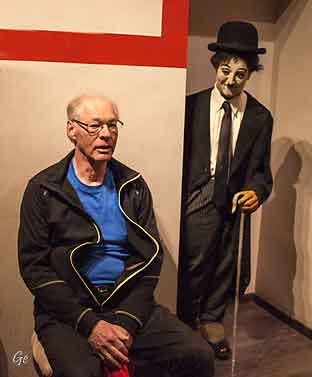 Voksmuseum |
||||||
| Tekst fra Gyldendals Reiseguider, Roma tilbake til 1. side |
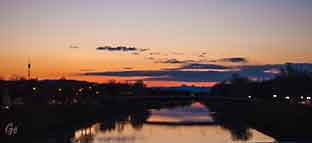 |
||||||
